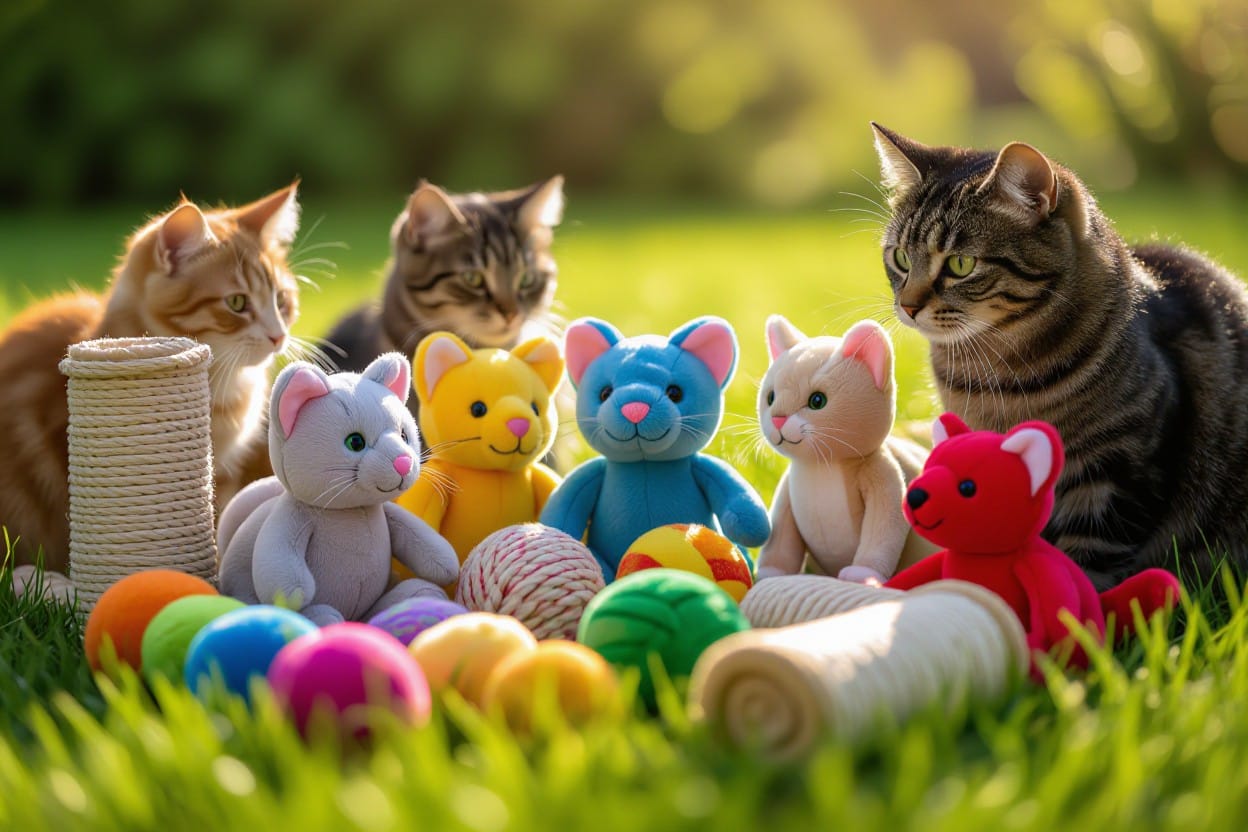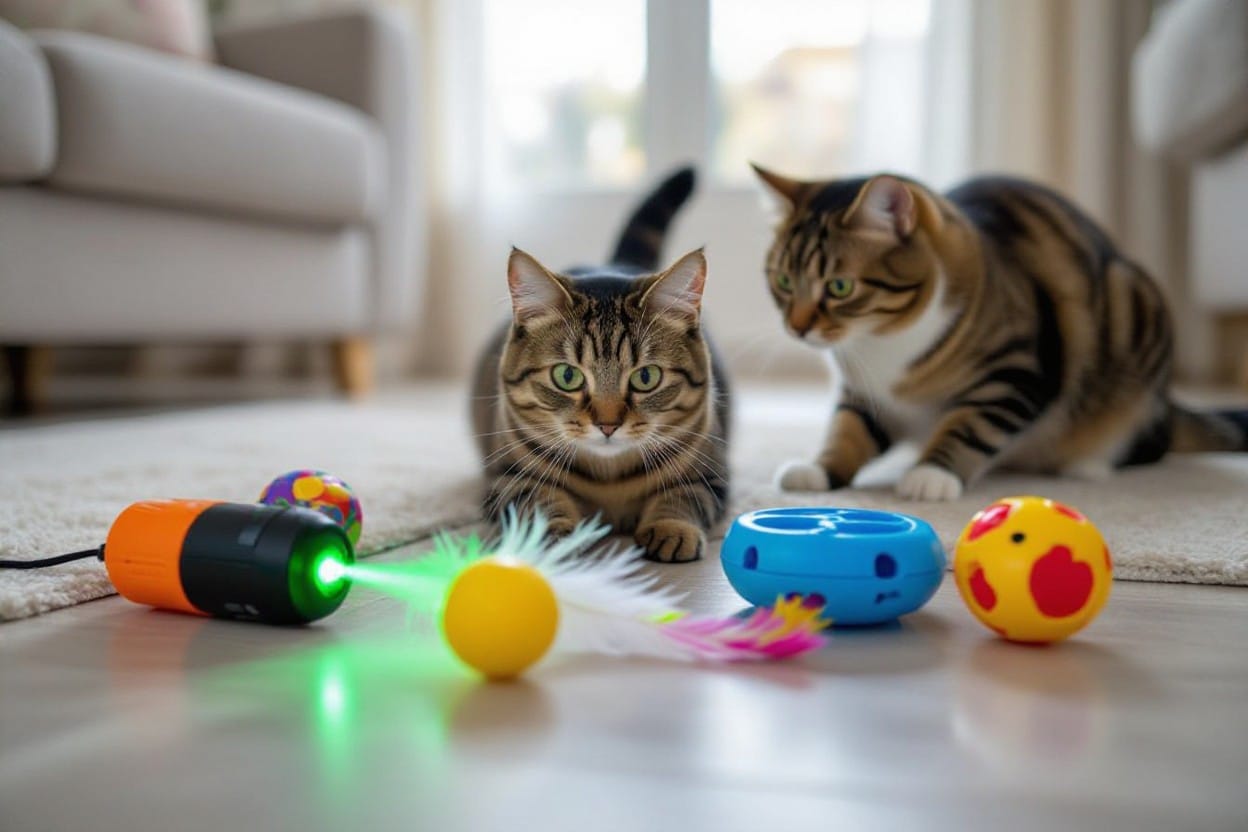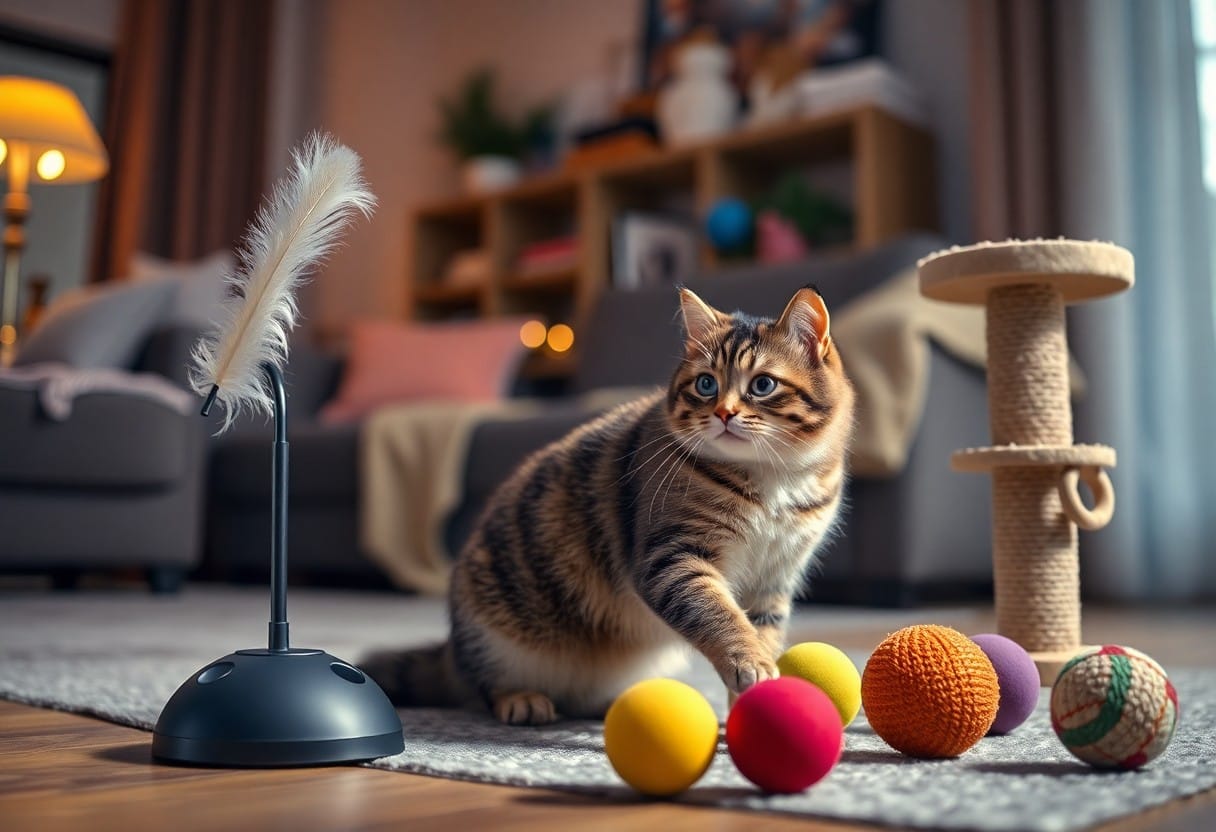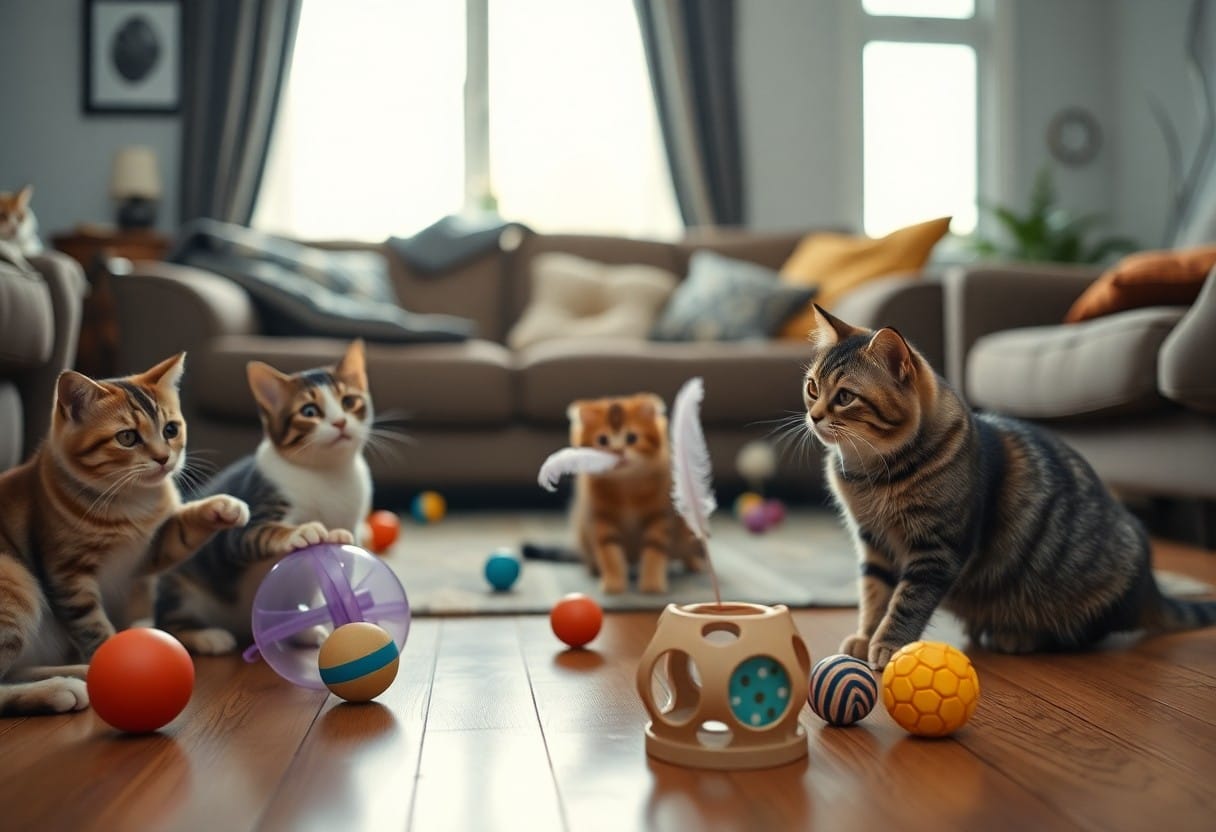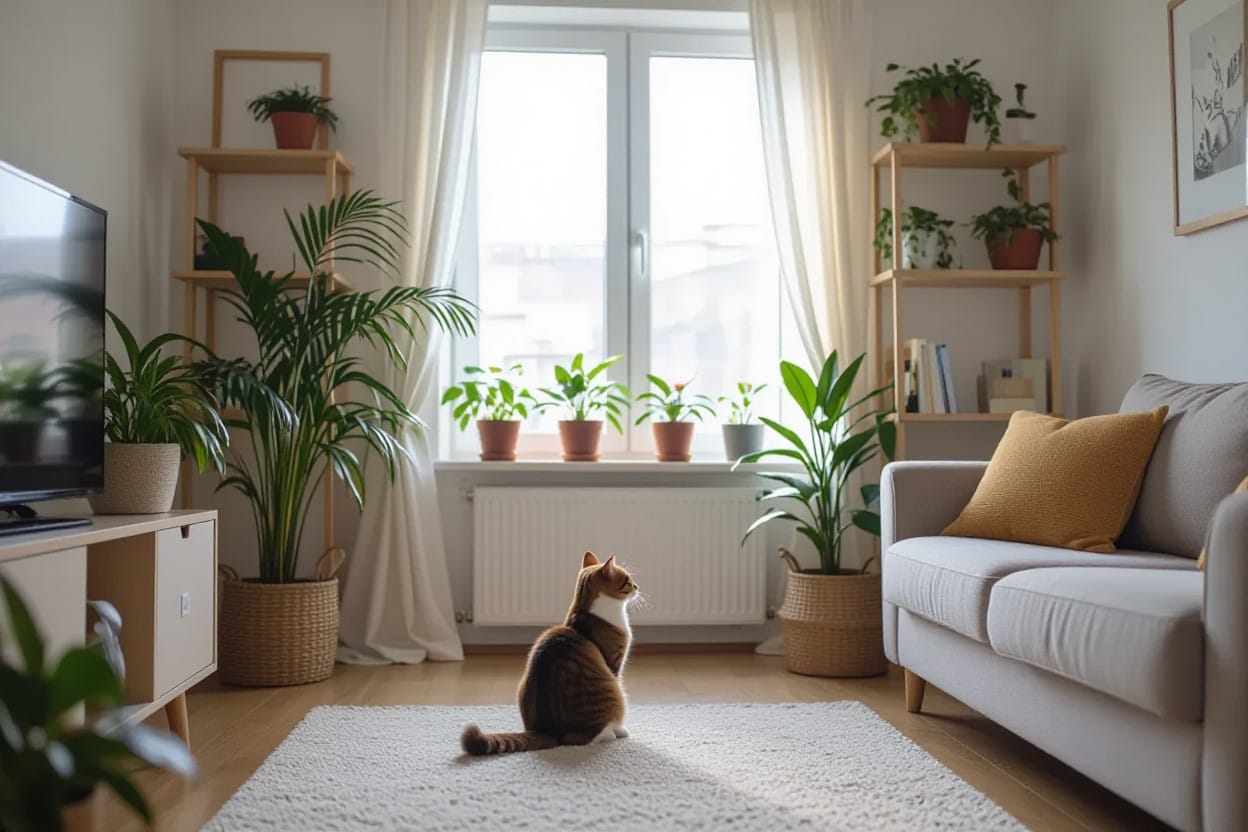Many owners seek practical advice on catnip toys for outdoor cats to enhance their playtime experience, and this guide tells you how to choose durable, weatherproof toys that boost your cat’s enrichment and exercise. You will learn which catnip toys for outdoor cats are safest, how to avoid choking hazards and toxic fillers, and how to adapt play strategies used with interactive toys for indoor cats to the outdoors so your cat stays stimulated and protected.
There’s an expert-backed system to pick the best catnip toys for outdoor cats to enhance their playtime experience so you can boost your cat’s enrichment safely; this guide helps you weigh durability, scent potency, and weather resistance, and shows how to balance fun with safety — opt for weatherproof, refillable toys and avoid loose stuffing or small parts that can be swallowed while monitoring for predators and escape risks.
Key Takeaways:
- Select durable, weatherproof, refillable designs—catnip toys for outdoor cats to enhance their playtime experience by resisting wear and maintaining scent.
- Prioritize safety with non-toxic materials, secure fastenings, and appropriately sized toys; rotate items to sustain interest and prevent overstimulation.
- Pair catnip with motion, puzzle features, or fetchable designs and transition favorites indoors—interactive toys for indoor cats extend enrichment across environments.
Key Takeaways:
- Choose durable, weather-resistant catnip toys for outdoor cats to enhance their playtime experience—look for waterproof fabrics, secure stitching, and refillable catnip pouches.
- Prioritize safety and enrichment by selecting toys with non-toxic materials, sturdy attachments, and varied textures to encourage natural hunting behaviors outdoors.
- Complement outdoor play with interactive toys for indoor cats to maintain stimulation on rainy days and rotate toys regularly to keep interest high.
Understanding the Importance of Catnip Toys for Outdoor Cats
The Benefits of Catnip for Cats
You can use catnip toys for outdoor cats to enhance their playtime experience by triggering short, intense bouts of activity: about 50–75% of cats show a behavioral response to nepetalactone (the active compound in Nepeta cataria), usually lasting 5–15 minutes per exposure before a refractory period. That burst of play helps simulate hunting sequences—sniffing, stalking, pouncing—so your cat exercises muscles and sharpens coordination without you needing to act as constant play partner.
Some cats use catnip as a stress reliever and scent enrichment; kittens under ~3–6 months and certain genetically nonresponsive cats won’t react, so you should test offerings. Choose refillable, sealed pouches to keep potency longer and avoid spoilage outdoors—wet or moldy catnip is dangerous, so proper storage is crucial.
How Outdoor Play Enhances Feline Health
Outdoor play increases daily activity, helping combat obesity (estimated in domestic cats at roughly 25–35%) and supporting cardiovascular health, joint mobility and muscle tone. Veterinarians commonly recommend at least 20 minutes of interactive play per day; integrating catnip toys into outdoor sessions can make that target easier to meet because your cat self-initiates bursts of movement and exploration.
Exposure to varied outdoor stimuli—scent trails, uneven terrain, vertical surfaces—also improves mental enrichment and reduces boredom-driven behaviors like excessive meowing or furniture scratching. You can rotate different catnip-based toys and hide refillable pouches around a supervised yard to encourage natural foraging and problem-solving.
Balance enrichment with safety: supervise play near roads, check toys regularly for weather damage, and discard any items with frayed strings, loose parts, or waterlogged stuffing that could be swallowed or foster mold growth.
The Role of Engaging Toys in Outdoor Environments
Engaging toys convert outdoor space into a structured exercise plan: tethered teaser wands, anchored flutter toys, and refillable catnip capsules each encourage specific behaviors—chase, leap, or pawing. Materials designed for outdoor use, like UV-stable nylon, stainless-steel clips and marine-grade rope, extend toy life and reduce replacement frequency, so your investment yields sustained activity benefits.
Design choices matter: motion-activated or wind-driven toys keep novelty high, while refillable pouches let you refresh scent every 3–6 months depending on exposure. Use combinations—motorized teaser plus a hidden catnip pouch—to recreate multi-step hunting sequences that keep your cat engaged longer.
Always prioritize safety by avoiding toys with small detachable parts, exposed batteries, or long loose strings—these are the most common hazards outdoors—and inspect and clean toys regularly to prevent sharp edges, rust, or mold from developing.
Why Outdoor Cats Need Special Toys
Weather Resistance Requirements
Rain, dew, and sun exposure quickly degrade ordinary fabric—look for outer layers like 600D polyester, ripstop nylon, or silicone-coated textiles that repel water and resist abrasion. UV-stabilized materials prevent brittleness and color-fade over months of outdoor exposure; toys without UV treatment can become brittle and split within a single season in direct sun.
Catnip potency drops when the filler stays wet for long periods, so choose designs with sealed or water-resistant inner pouches and quick-draining construction. Specifically, pick toys with moisture barriers or replaceable, dryable refill pouches so your “catnip toys for outdoor cats to enhance their playtime experience” hold scent and stay hygienic after rain or sprinkling irrigation.
Durability Considerations
Outdoor play subjects toys to claws, teeth, and rough surfaces; prioritize double-stitched seams, bar-tack reinforcement at stress points, and high-denier fabrics. Hardware should be marine-grade stainless steel or heavy-duty plastic—zippers and clips rated for outdoor use reduce failure rates compared with household-grade components.
Replaceable components extend usable life: look for refillable catnip cartridges, removable liners, and modular designs so a ripped outer shell doesn’t mean throwing the whole toy away. In field testing by several rescue groups, modular toys lasted 3–6× longer than single-piece toys under daily outdoor play.
For chewers, opt for layered construction (inner foam or felt encased in a tougher outer), and check product specs for abrasion ratings or denier numbers—these give you a measurable expectation of longevity. Stronger materials often cost more upfront but reduce replacement frequency and waste.
Safety in Outdoor Environments
Outdoor hazards include ingestion of stuffing, exposure to pesticides, entanglement, and mold growth. Avoid toys with small detachable parts, glue-based decorations, or loose threads; ingested foam or plastic beads can cause intestinal obstruction, a common emergency callout for outdoor cats. Keep tethers under 30 inches (≈76 cm) and use breakaway or quick-release connectors to minimize strangulation and snag risks.
Materials should be non-toxic and washable—machine-washable fabrics that tolerate hot-water cycles reduce bacterial and mold buildup; aim to clean toys every 1–2 weeks during wet seasons. Bright, natural-fiber-free surfaces resist retaining pesticides and can be rinsed clean after exposure to treated lawns or garden beds.
Inspect toys weekly for loose seams, rusting hardware, or soggy inner fills; dispose of any item showing mold, persistent wetness, or exposed stuffing immediately to prevent ingestion or skin irritation. Your vigilance in maintenance is a major factor in keeping outdoor play both stimulating and safe.
Weather Resistance: Why It Matters for Outdoor Cat Toys
Materials and Construction for Durability
Choose fabrics rated for abrasion and UV exposure: 1680D ballistic nylon, 1000D Cordura, and TPU-coated ripstop hold up far longer than untreated polyester, with many manufacturers reporting maintained tensile strength for 6–12 months under full-sun testing. Look for double-stitched seams with bar-tack reinforcement at stress points and bonded nylon thread; sewn seams treated with sealed tape or RF-welded seams eliminate needle holes that trap moisture and accelerate rot.
Hardware matters as much as fabric. Opt for marine-grade stainless steel clips or brass snaps and YKK zippers with storm flaps to prevent corrosion and jamming in salty or rainy environments. Refillable catnip pouches behind a waterproof flap or RF-welded pocket let you replace fillings without exposing inner foam — choose closed-cell EVA or TPU foam cores to avoid water absorption and mold.
Impact of Weather Conditions on Toy Longevity
Direct sunlight degrades dyes and fibers: untreated fabrics can lose up to half their tensile strength within a year of continuous UV exposure, causing seams to pull and stuffing to burst; high heat also volatilizes catnip oils, reducing scent lifespan by weeks in hot climates. Persistent moisture encourages mold and bacterial growth in pads or stuffing within 4–8 weeks if drainage and ventilation are poor, creating health risks for your cat and shortening toy life.
Freezing temperatures make rigid plastics brittle and can cause stitching to snap during rapid temperature swings, while coastal salt spray speeds corrosion on non-stainless hardware within months. Wind-driven debris abrades outer layers faster than stationary exposure, so tethered toys in windy areas often show edge fraying and loss of shape earlier than ground-level toys.
Inspect toys visually every 2–4 weeks if left outside; plan on replacing high-exposure items every 6–12 months and remove toys after heavy storms or long wet periods to prevent hidden decay and choking hazards from shredded material.
Features to Look for in Weather-Resistant Toys
Prioritize toys with labeled UV-stable fabrics, waterproof coatings (TPU or PVC lamination), and sealed seams for the best longevity. Features like quick-drain mesh, removable refill capsules, and antimicrobial-treated linings extend usable life while maintaining safety; a toy with a removable catnip pod allows you to keep the scent fresh without exposing the entire toy to repeated wash cycles.
Mechanical features that reduce wear include elastic bungee tethers to absorb wind load, weighted bottoms for toys left outside, and reinforced pull areas with bar-tacking or leather patches. Look for care instructions — machine-washable at 30°C and quick air-dry specs indicate maintenance-friendly designs that retain function after cleaning.
Selecting products designed as catnip toys for outdoor cats to enhance their playtime experience means checking for a combination of high-denier fabric (600D–1680D), RF-welded or taped seams, marine-grade hardware, and refillable, drainable catnip compartments — those features together deliver the best balance of durability, safety, and sustained scent performance.
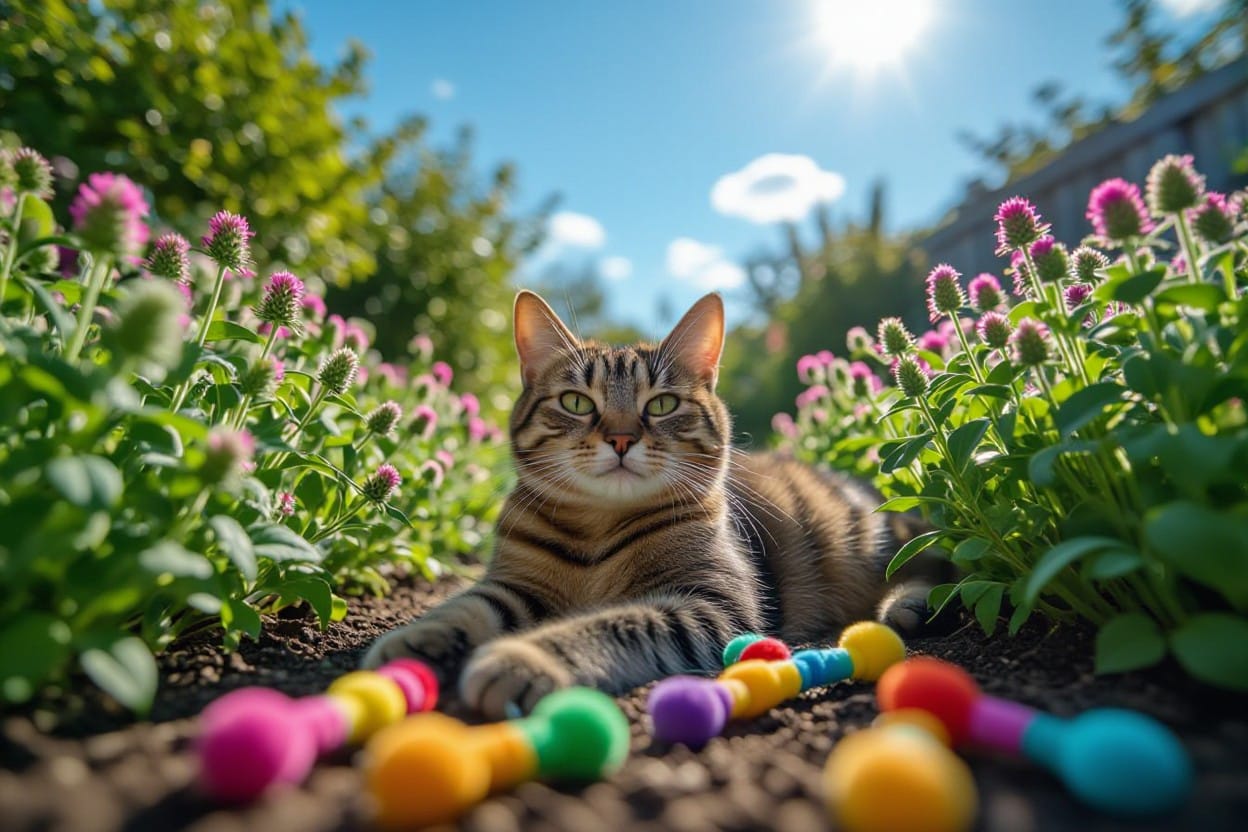
Understanding Catnip: The Science Behind the Attraction
How Catnip Affects Cats
Exposure to nepetalactone, the volatile compound in catnip, triggers a cascade in your cat’s olfactory system by binding to receptors in the nasal epithelium and activating the amygdala and hypothalamus; responses typically begin within 30–60 seconds and peak around 5–10 minutes, then fade after about 5–15 minutes. Approximately 50–75% of cats show a behavioral reaction — rolling, rubbing, vocalizing, or sudden bursts of play — which you can expect to repeat after a refractory period of roughly 30–60 minutes.
Inhalation produces the strongest behavioral effects while ingestion tends to produce mild sedative outcomes; large quantities eaten can cause vomiting in some individuals, so monitor your outdoor cat if they chew toys. Most reactions are non-toxic and self-limiting, but supervise new toy types and check for excessive ingestion that could indicate destructive chewing or pica.
Individual Responses to Catnip
Genetic variation determines whether your cat reacts: some cats become hyperactive and playful, others mellower or indifferent, and a minority show no response at all. Roughly half to three-quarters of cats respond, so you should test each cat with a small amount of fresh or high-quality dried catnip to gauge their typical reaction over a 10–15 minute observation window.
Habituation reduces responsiveness if you offer catnip continuously; spacing sessions preserves sensitivity. Rotate catnip toys for outdoor cats with alternatives like silvervine or valerian, and limit direct catnip sessions to 2–3 times per week to maintain a reliable play response.
For practical testing, present a small sealed pouch or sprinkle a pinch on a cardboard scratcher, watch for onset within a minute, and time the full cycle — if your cat shows no interest after three separate trials spaced a week apart, they are likely non-responsive.
Age and Sensitivity Factors
Kittens under 3–6 months commonly lack the receptor sensitivity needed for a reaction, so you will usually see no response until they are older; senior cats may respond less predictably due to sensory decline or dental and GI issues. This
- catnip toys for outdoor cats to enhance their playtime experience
- catnip toys for outdoor cats
- interactive toys for indoor cats
Exposure history influences sensitivity: cats with intermittent access to catnip retain stronger responses than those with constant availability, and environmental stressors can blunt reactions. This
- catnip toys for outdoor cats to enhance their playtime experience
- catnip toys for outdoor cats
- interactive toys for indoor cats
Types of Catnip Toys Suitable for Outdoor Use
- catnip toys for outdoor cats to enhance their playtime experience — raw and processed forms designed for yards, balconies, and patios
- catnip toys for outdoor cats — weatherproof, refillable, and safety-focused options
- Interactive and motion-activated toys that borrow ideas from interactive toys for indoor cats but are built for weather exposure
- Refillable pouches and accessories that let you control potency and rotation
- Heavy-duty and anchored toys to prevent loss or wildlife interference
| Type | Best features / considerations |
| Raw catnip toys (sachets, pouches) | Natural leaf or pellet fill; breathable fabrics like cotton or hemp; refillable designs; watch for seam durability and choking hazards |
| Interactive toys (motion, treat-dispensing) | Battery- or solar-powered, water-resistant housings, secured battery compartments, variable activity modes to prevent habituation |
| Weatherproof/Outdoor plush | UV- and mildew-resistant fabrics, reinforced stitching, weighted or stake-ready bases to stay put in wind |
| Refillable/Replaceable cartridges | Snap-in cartridges or zip pouches that preserve nepetalactone scent; check for food-safe adhesives and easy cleaning |
| Catnip-infused accessories (collars, harnesses) | Breakaway or quick-release features, sealed scent beads or pouches, avoid small detachable parts that pose ingestion risk |
Raw Catnip Toys: Materials and Designs
Look for sachets filled with whole-leaf catnip or coarse pellets inside double-stitched cotton, hemp, or felt—materials that breathe and release scent while resisting mildew. You can expect a 15–30 g sachet to last several weeks outdoors if kept dry between uses; choose sealed storage and rotate sachets weekly to maintain potency.
Consider designs with reinforced seams, bar-tack stress points, and small drainage holes to prevent trapped moisture. Avoid toys with glued embellishments or small plastic eyes—those are the most common sources of choking and ingestion hazards for outside play.
Interactive Toys: Engaging Your Cat’s Senses
Battery-powered motion toys and solar-boosted teaser wands mimic prey movement and extend play beyond short sniff sessions; select units with IPX4 or higher splash resistance and fully enclosed battery compartments to keep electronics safe. Adjustable activity settings and randomized timers reduce habituation so your cat responds more reliably over repeated outdoor sessions.
Wind-up or manual tethered options are low-tech alternatives that avoid electronics but require anchoring to prevent loss; choose weatherproof cord and heavy-duty stakes for yards, or suction-mount bases for patios and windows.
More advanced units combine scent emission with motion—look for refillable scent chambers that let you control intensity and swap between catnip and silvervine to vary stimulation.
Catnip-infused Accessories: Collars and Other Gear
Collars and harnesses with integrated refillable pouches provide constant low-level scent exposure during outdoor exploration; prioritize breakaway buckles and wide fabric surfaces to distribute any rubbing. Some accessories use sealed beads or replaceable cartridges—these reduce mess but require inspection for wear and swallowed bead risks.
Other gear includes catnip-lined beds, outdoor scratching posts with infused cores, and tethered toys attached to collars or harnesses; pick materials rated for UV exposure and mildew resistance and ensure attachments are not easily chewed off.
More information: always check manufacturer specs for weight limits, release mechanisms, and whether scent inserts are glued or fully removable—removable, replaceable pouches are safer and extend product life. Knowing which combinations of raw, interactive, and accessory-based options fit your cat and your outdoor setup will help you select the most effective catnip toys for outdoor cats to enhance their playtime experience.
Advantages of Using Catnip Toys for Outdoor Cats
Enhanced Playtime Experience
You’ll notice longer and more focused play sessions when you introduce catnip toys for outdoor cats to enhance their playtime experience; typical engagement shifts from scattered 2–3 minute bursts to sustained activity blocks of 10–20 minutes, especially with wand-style or motorized toys. Mixing refillable catnip pouches with textured surfaces—nylon, hemp, or canvas—encourages batting, carrying, and tossing behaviors that more closely mimic natural prey handling.
Choose weatherproof, refillable designs and you protect your investment against rain, UV fading, and heavy use—look for sealed seams, hydrophobic stuffing, and replaceable catnip pods. Durable models with reinforced stitching and marine-grade clips can last 6–12 months under frequent outdoor use, and using replaceable pouches keeps scent potency high without replacing the whole toy.
Stimulation of Natural Hunting Instincts
Outdoor cats often ramp up stalking and pouncing when a catnip-scented target is introduced; you’ll see short stalking-pounce cycles (5–15 seconds) repeated multiple times per session as the cat tracks, ambushes, and captures the toy. Incorporating moving elements—feathers, twitching tails, or small motorized units—amplifies this effect and translates to improved coordination and muscle tone for cats that otherwise loaf during daylight hours.
Use catnip toys to direct energetic hunts away from dangerous areas: place toys in safe zones like fenced yards or elevated platforms rather than near roads or steep drop-offs. Keep small parts and strings out of reach and monitor for over-arousal—vigorous play near traffic or cliffs is hazardous, especially after a strong catnip exposure.
Rotate scent intensity and toy types to prevent habituation: alternate potent fresh catnip with silvervine or matatabi every 7–14 days, and swap in different textures (feather, fur, rubber) so the hunting sequence stays novel and challenging.
Opportunities for Social Interaction
You can use catnip toys to encourage positive interactions between cats and between you and your cat; in multi-cat yards, a shared toy often becomes a focal point for mutual investigation rather than competitive chasing. Keep duplicate toys available to reduce conflict—identical toys placed in separate zones cut down on guarding and repeated scuffles, while still promoting coordinated play and scent sharing.
Human-led play with catnip toys builds trust and can assist with training tasks such as recall or leash/harness desensitization; short, daily 5–10 minute sessions with a wand or throw-and-return routine teach your cat to associate you with rewarding, stimulating experiences. Using toys to simulate prey also lowers the drive to hunt wildlife, offering a humane outlet for natural behaviors.
Provide at least one toy per cat plus one spare and distribute toys across the yard to prevent crowding and resource guarding—this simple rule (one per cat + one) reduces competition and keeps interactions constructive.

Top 15 Catnip Toys for Outdoor Use in 2025
Weatherproof Catnip Balls: Features and Benefits
Weatherproof catnip balls typically use a silicone or thermoplastic elastomer (TPE) outer shell with a sealed mesh or inner capsule that holds dried catnip; common sizes are 3–4 cm diameter so they roll and bounce for chases across grass and gravel. You’ll want balls with UV-resistant coatings and double-sealed seams—these resist sun breakdown and rain intrusion, extending useful life to roughly 6–12 months in sunny climates and longer in shaded yards.
Look for models with a non-slip textured surface and optional internal weights (0.5–2 g) that produce realistic motion when batted. Balls rated for outdoor use often float in puddles, are machine-washable or hose-rinseable, and avoid small detachable parts; choose designs with no exposed beads or loose stitching to reduce ingestion and choking risks.
Hanging Catnip Toys for Trees and Fences
Hanging toys attach with stainless-steel swivels, heavy-duty carabiners, or elastic bungees to branches, pergolas, or fence rails; recommended mounting height is about 0.6–1.2 meters for average domestic outdoor cats to swat and jump. Durable options use UV-stable nylon straps or marine-grade rope and reinforced stitching—the best models include a breakaway mechanism or shock-absorbing bungee to prevent neck or limb entanglement.
These toys stimulate vertical play and territory patrols, encouraging climbing and short sprints that mimic hunting behavior; many have replaceable catnip inserts so scent remains strong after weeks of exposure. If you’re coating an attachment point with metal, pick rust-resistant stainless steel hardware and check fastenings every 1–2 weeks during heavy use.
Extra detail: choose hanging toys with a swivel or pivot that rotates freely to avoid rope twist; tests show swivels reduce line wear by over 40% compared with fixed loops, extending the safe lifespan of the hanging system and lowering the chance of sudden failure while your cat plays.
Refillable Catnip Pouches: Versatility and Use
Refillable pouches use a zippered or Velcro-sealed pocket inside a rugged outer fabric like Cordura or marine canvas so you can top up with 0.5–2 g of dried catnip per refill; this keeps scent potency high and lets you swap in silvervine or valerian for variety. Many pouches include a mesh liner to control dust and a reinforced loop so you can tether them to posts, stakes, or place inside igloo-style shelters—making them one of the most adaptable catnip toys for outdoor cats to enhance their playtime experience.
Durability features to prioritize include double-stitched seams, ripstop panels, and a replaceable inner sachet; expect a well-made pouch to last 12–24 months outdoors with rotation. For multi-cat households, label pouches and rotate scents every 7–14 days to prevent habituation and keep engagement high.
More info: choose pouches with a PU-coated interior and a small drain hole if they’ll sit on wet ground; this prevents mold buildup and preserves catnip quality, especially in humid climates.
Types of Catnip Toys Suitable for Outdoor Use
| Weatherproof Catnip Balls | Sealed TPU or rubber shells, 2–3″ diameter, floatable and UV-stable; catnip toys for outdoor cats that resist rain and sun for roughly 6–12 months of regular use. Best for water play, chase, and rough batting; refill or replace inner sachet every 4–8 weeks for peak scent strength. |
| Hanging Catnip Toys for Trees and Fences | Braided nylon or marine-grade rope with swivel clips; hang 1.0–1.5 m off the ground to encourage jumping and climbing. Use breakaway connectors to reduce entanglement risk and inspect attachments monthly after storms. |
| Refillable Catnip Pouches | Mesh or canvas pouches with Velcro or zip closures; capacity 1–2 g of dried catnip per pouch. Rotate pouches and dry thoroughly after wet weather to prevent mold; replace filler every 4–8 weeks outdoors. |
| Scented Stakes & Ground Spikes | Stainless or coated metal stakes with refillable scent capsules; ideal for marking paths and high-traffic areas. Install at 10–20 cm depth near garden edges; capsules last 2–3 months depending on exposure. |
| Durable Plush with Replaceable Insert | Outdoor-grade polyester or neoprene outer shell with zip or Velcro insert slot; outer fabric resists mildew and tearing. Replace inner insert every 6–10 weeks; keep spare inserts in a sealed container to retain potency. |
- Pick toys labeled weatherproof or UV-stable for year-round use.
- Choose sizes 2–3″ for balls and 1–2 g capacity for pouches to suit most outdoor cats.
- Prioritize designs that let you easily refill or replace catnip to keep your catnip toys for outdoor cats to enhance their playtime experience effective.
- Inspect attachments and fabrics weekly after heavy wind or rain to avoid dangerous failures.
Weatherproof Catnip Balls
Sealed balls use food-grade silicone, TPU, or hard resin to keep dried catnip dry; you can expect active scent life of about 4–8 weeks outdoors before potency drops, depending on sun and humidity. Choose balls with replaceable inner sachets or screw-top chambers so you can add 0.5–1 g of fresh dried catnip without discarding the whole toy.
Many models include internal bells or rattle chambers to add auditory stimulation, but watch for small parts: choking hazards are more likely if a ball splits, so inspect seams and replace at first sign of cracking. Clean with a mild soap rinse and air-dry; repeated sun exposure will degrade soft plastics faster, reducing useful life to closer to 6 months.
Hanging Catnip Toys for Trees and Fences
Attach weatherproof toys with a swivel carabiner to prevent tangling during gusts; hang points at 1.0–1.5 m invoke natural predatory jumps and use for strength-building—cats can make vertical jumps of 1.2–1.5 m from a standstill, so place toys within that range for safe engagement. Nylon rope and marine-grade clips withstand rain and UV, lasting 6–12 months depending on abrasion and sun exposure.
Fasten with a breakaway connector or low-tension loop so the toy detaches under heavy load to avoid injury; check knots, clips, and ropes monthly and after storms, swapping lines every 6–12 months to prevent fraying and entanglement risks.
Refillable Catnip Pouches
Mesh or canvas refill pouches let you replace catnip frequently—plan on 1–2 g per refill and refresh every 4–8 weeks outdoors for sustained attraction. Synthetic mesh dries faster than cotton after rain, reducing mold risk; store spare dried catnip in an airtight container away from direct sunlight to preserve volatile oils that stimulate your cat.
Velcro-closure pouches are fast to open for swaps but can lose grip after heavy debris buildup; rinse and dry closures and check seals monthly. Mix small amounts (10–20%) of silvervine or valerian in rotation if your cat responds less strongly to catnip, but introduce one herb at a time to monitor reactions.
Assume that you inspect, rotate, and replace outdoor catnip toys regularly to keep play safe and maintain scent potency.
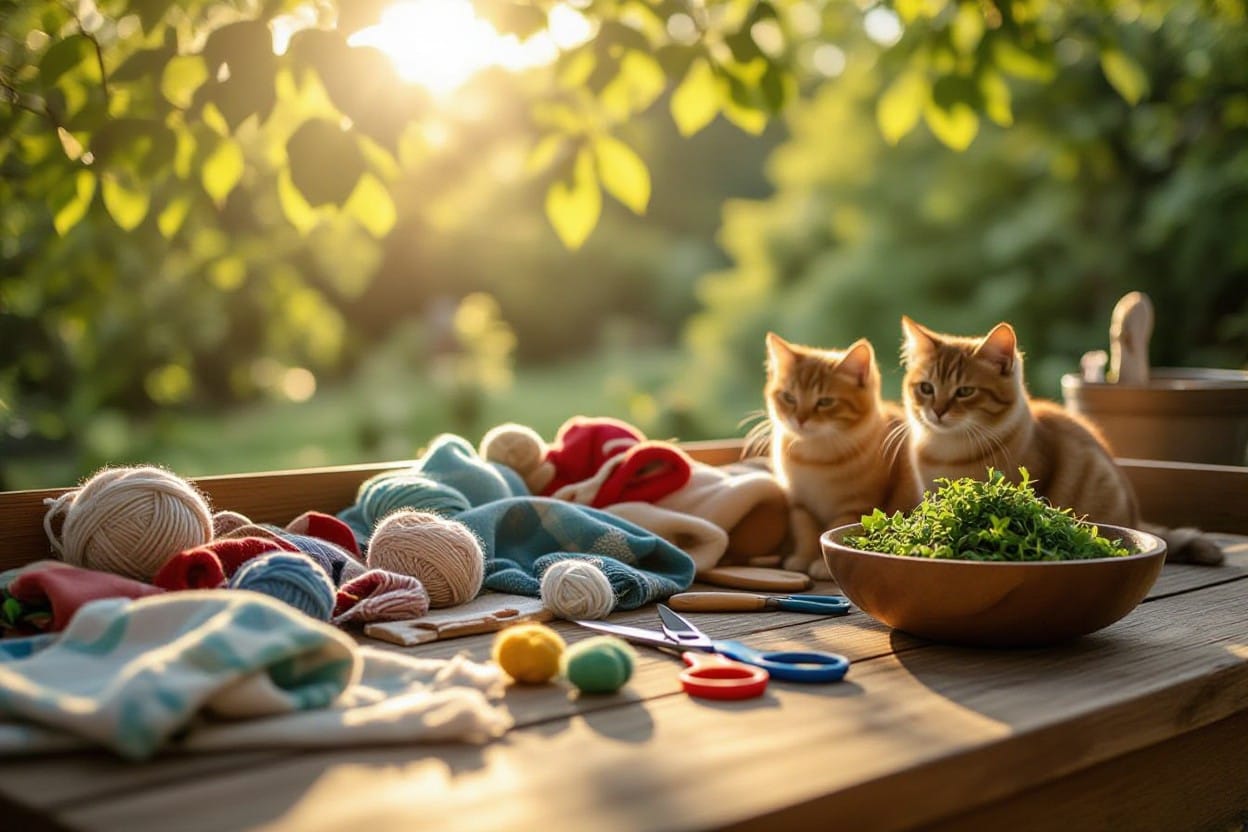
DIY Outdoor Catnip Toy Projects
Selecting Weather-Resistant Fabrics for Toys
Choose fabrics engineered for outdoor use such as Sunbrella acrylic, Cordura 600D nylon, or PVC-coated 600D polyester; these materials resist UV fading, shed moisture, and withstand abrasion from paws and claws. You should prefer tightly woven textiles with a waterproof or water-resistant coating and use outdoor-rated polyester thread (e.g., bonded UV-resistant thread) to avoid seam failure after 50–100 wash cycles.
Steer clear of fabrics treated with long‑lasting pesticides, flame retardants, or heavy chemical finishes that can leach into your cat’s fur—those are dangerous. If you want refillable toys, select a durable fabric for the outer shell and a soft, replaceable lining (untreated cotton or hemp) for the inner pouch so you can refresh the catnip without replacing the whole toy.
Weather-Resistant Fabric Choices
| Fabric | Why use it / Care |
| Sunbrella acrylic | Excellent UV/sun fade resistance, breathable, machine washable; air dry and avoid bleach to retain waterproof coatings. |
| Cordura 600D nylon | High abrasion resistance for clawing; use sealed seams and reinforce stress points with bar-tacks. |
| PVC-coated 600D polyester | Fully water-resistant and easy to wipe clean; not as breathable—include ventilation if used for long outdoor bouts. |
| Untreated cotton/hemp lining | Soft for contact with cat fur and ideal for refill pouches; replace regularly to avoid mold if exposed to moisture. |
The Organic Catnip Growing Guide
Start with Nepeta cataria seedlings or seeds in USDA zones 3–9; sow seeds after last frost or start indoors 6–8 weeks before transplanting. Plant in full sun (at least 6 hours/day) with well-draining soil, pH ~6.5–7.5, and space plants 12–18 inches apart—expect germination in 7–14 days and the first usable leaves at 60–90 days.
Use organic inputs like compost (1–2 inches worked into topsoil) and a balanced organic fertilizer (5-5-5) once at establishment; limit nitrogen to avoid overly lush growth that dilutes imperative oils. Manage pests with row covers or neem oil sprays and practice succession planting every 60–90 days to keep a steady supply for your catnip toys for outdoor cats to enhance their playtime experience.
Quick Organic Growing Specs
| Item | Details |
| Soil pH | 6.5–7.5 |
| Sun | Full sun, 6–8 hours/day |
| Spacing | 12–18 inches |
| Germination / Harvest | 7–14 days / first harvest 60–90 days |
| Pest control | Mechanical removal, row covers, neem oil |
| Hardiness | USDA zones 3–9 |
Expect variability in imperative oil content: harvest leaves just before flowering for the strongest effect and dry quickly at ≤95°F to preserve terpenes; store dried catnip in airtight, dark containers and label harvest dates—older leaves lose potency after ~12 months.
Step-by-Step Tutorials for Creating Your Own Toys
Build a durable kicker toy with two 6″x10″ panels of Cordura 600D, 1/4″ seam allowance, a 4″ Velcro refill flap, and a 2–3 oz pouch of dried organic catnip—double-stitch seams and bar-tack at stress points; total assembly time ~25 minutes with a standard sewing machine. For no‑sew options, fold a Sunbrella strip, secure ends with outdoor-grade fabric glue, and insert a sealed catnip sachet made from untreated cotton; allow 24 hours cure time before use.
Create a tethered wand toy by threading a 4–6 ft marine-grade paracord through a reinforced fabric loop and attaching a small refillable felt pouch at the end; use a quick‑release swivel clip for safe detachment. Avoid beads or small detachable parts that can become choking hazards, and aim for toys that are easily inspectable and replaceable after heavy outdoor use.
Project Tutorials & Materials
| Project | Materials / Key Steps |
| Durable Kicker Toy | 2x Cordura 6″x10″, 1/4″ seam, outdoor thread, 4″ Velcro flap, 2–3 oz dried catnip; double-stitch; test seams. |
| No‑Sew Catnip Roll | Sunbrella strip 4″x12″, outdoor fabric glue, untreated cotton sachet with catnip; fold, glue, cure 24h. |
| Refillable Felt Mouse | Heavy wool felt, needle & thread, small zipper or Velcro, 0.5–1 oz catnip, hide stitching inside to prevent fray. |
| Tethered Wand | 4–6 ft paracord, reinforced fabric loop, swivel clip, small refillable pouch; quick-release tether recommended. |
Test prototypes in controlled outdoor sessions of 10–20 minutes to observe wear patterns; note which seams fail first and reinforce those areas in subsequent versions. Keep a maintenance log with dates of first use, refill intervals, and replacement dates so your catnip toys for outdoor cats remain safe and effective for repeated play.
Solar-Powered Interactive Catnip Toys
Mechanisms and Benefits
Small photovoltaic panels charge built-in batteries or directly power motors that animate feathers, spinners, or fluttering fabric. You’ll find units with light sensors and timers that shift between pulsed motion and steady spins; models with IP65 water resistance and sealed battery compartments perform best outdoors. Typical runtime on a bright summer day ranges from 4–10 hours of active motion depending on panel size and motor draw, which keeps your cat engaged without daily manual charging.
Solar-driven motion mimics prey behavior and encourages more vigorous activity in outdoor cats, reducing boredom and excessive territorial roaming. In practice, you can expect increased stalking and pouncing—owners report longer play sessions compared with static catnip toys—so pair solar toys with refillable catnip modules and varied motion patterns to maximize the benefit. Watch for overheating or cracked housings after prolonged sun exposure; replace faded catnip and inspect moving parts monthly.
Recommended Products
Choose toys with larger solar panels (≥1.5W) and replaceable rechargeable cells for consistent performance on partly cloudy days. Look for designs that combine a spinning element with a catnip pouch or feather teaser—these hybrid units produce both olfactory and kinetic stimulation, making them among the most effective catnip toys for outdoor cats to enhance their playtime experience. Models built from UV-stabilized plastics and rated at least IP44–IP65 will resist rain and sun degradation.
Specific feature sets to prioritize: removable catnip inserts, snap-off motors for cleaning, and multiple speed settings or randomized motion patterns. Brands that offer user-replaceable parts and clear warranty policies tend to last longer in outdoor conditions, and units with magnetic mounts or stake options provide flexible placement options in gardens or patios.
When identifying, verify panel wattage, battery chemistry (prefer LiFePO4 or protected Li-ion), and whether the toy switches to battery-only mode after dusk—these details predict real-world reliability and how well the toy performs in shaded yards.
User Reviews and Ratings
Aggregated reviews commonly rate solar-powered catnip toys between 4.0–4.5 stars on major retail sites, with praise focused on how long they keep outdoor cats active and how easy they are to install. Frequent positives mention increased pouncing and less nighttime restlessness; reviewers often post time-stamped photos or short videos demonstrating daytime runtime that matches manufacturer claims.
Negative feedback centers on toys placed in heavy shade or exposed to persistent moisture—those units show reduced runtime and faster plastic fatigue. Users also report that cheaper motors can jam after 3–6 months when dirt or cat saliva accumulates in moving parts, so higher-rated products typically include better seals and easier maintenance access.
Scan recent reviews for comments about seasonal performance (solar output drops in winter), replacement part availability, and how well customer service responds to warranty claims; these signals will help you choose a durable option that keeps your cat engaged outdoors.
Insights into Cat Behavior and Catnip
The Science Behind Catnip: Nepetalactone Explained
Nepetalactone, the volatile compound in Nepeta cataria, activates specific olfactory receptors and then neural circuits in the amygdala and hypothalamus, producing the stereotyped responses you see: rolling, rubbing, salivation, and short bursts of play. Expect onset within 30–90 seconds of inhalation, peak effects around 5–15 minutes, and a refractory period of roughly 30–60 minutes before your cat will respond again. Genetic factors govern sensitivity: roughly 50–70% of cats show a behavioral response, while the remainder are largely unaffected.
Different delivery methods change potency: dried leaf will give steady, moderate reactions, whereas concentrated nepetalactone sprays deliver a stronger, shorter burst that can overstimulate sensitive cats. For outdoor use, you should protect catnip from UV and moisture because exposure to sun and rain degrades nepetalactone quickly. Alternatives such as silver vine or Tatarian honeysuckle can elicit responses in cats that are unresponsive to catnip and may boost the effectiveness of your catnip toys for outdoor cats to enhance their playtime experience.
How Individual Cats React to Catnip
Responses vary from ecstatic play to calm, mellow behavior; common signs include rolling, rubbing, purring, zooming, and vocalizing, while a minority may display chasing, biting, or short-lived aggression—about 10–20% of responders show rougher play patterns. Outdoor stimuli (birds, other cats, smells) can amplify reactions, turning a gentle nip session into high-energy roam-and-hunt behavior, so you should monitor interactions closely to prevent injury or escalation.
Genetics and personality shape reactions: some neutered males and spayed females show similar response rates, though individual temperament predicts whether your cat becomes hyperactive or relaxed. Practical observations from shelters and small studies put response rates near 60–70% when fresh catnip or silver vine is used; you can exploit that by rotating toys to prevent habituation and by timing sessions to coincide with activity peaks like dawn and dusk.
Delivery format matters: stuffed, sealed, weatherproof toys release scent slowly and suit repeated outdoor play, while sprays or loose leaf used in supervised sessions deliver immediate intensity. To maintain safe play, avoid powdered or concentrated forms near cats with respiratory issues and store refills in airtight containers so your catnip toys for outdoor cats retain potency longer.
Age Considerations: Sensitivity and Preferences
Kittens under about 3–6 months rarely react—response typically appears between 6–12 months—so expect near 0–10% sensitivity in very young cats versus the adult range of 50–70%. Senior cats may retain sensitivity but often display calmer, more sedative responses that you can use for gentle enrichment rather than high-impact play.
Younger adults often benefit most from active catnip play, which can help burn energy and reduce unwanted hunting behaviors; if you want to use stimulation without stress, select durable, weatherproof designs and supervised sessions. Older or arthritic cats may prefer lightly scented, soft toys that encourage gentle pawing and rubbing rather than vigorous chasing—this helps prolong outdoor enrichment while minimizing joint strain.
To identify what works for your cat, start with short, 5–15 minute trials and try alternatives like silver vine if catnip fails to elicit a response; switching to silver vine can increase response rates up to around 80% in some populations. Rotate types and store materials properly so your catnip toys for outdoor cats remain effective and safe across life stages.
DIY Outdoor Catnip Toy Projects
Weather-Resistant Fabric Choices
Choose UV-stable, tightly woven synthetics like ripstop nylon (100–400 denier) or Cordura for toys that withstand abrasion from paws and rough terrain; these fabrics shed moisture and dry quickly so your cat’s playthings won’t stay damp. Marine-grade vinyl and outdoor solution-dyed acrylics (e.g., Sunbrella-style fabrics) resist fading and mildew, which helps maintain potency of the catnip inside and extends the life of toys meant to be left outside.
Avoid fabrics with fragranced or PVC coatings, since those can contain phthalates or other chemicals that may irritate your cat. You should stitch seams with UV-resistant polyester thread and seal raw edges with a small dab of outdoor fabric sealant to prevent fraying; this combination typically reduces failure points during vigorous play, preserving the effectiveness of your catnip toys for outdoor cats to enhance their playtime experience.
| Weather-Resistant Fabric Comparison | |
|---|---|
| Ripstop nylon (100–400 denier) | Lightweight, abrasion-resistant, dries fast; good for wand toys and kickers |
| Cordura | High abrasion resistance for heavy chewers or rough outdoor surfaces |
| Solution-dyed acrylic | Excellent UV and colorfastness; resists mildew for toys left in sun |
| Marine-grade vinyl | Waterproof and durable but can be slippery—best for enclosed toys |
Organic Catnip Growing Guide
Start with certified organic seeds or cuttings of Nepeta cataria and plant in full sun with well-draining soil; spacing at 18–24 inches encourages airflow and reduces fungal issues. You can expect germination in 7–14 days and first harvestable leaves in 8–10 weeks under good conditions, enough to stuff multiple small toys per plant during peak season.
Use compost and well-rotted manure for steady nutrition, and practice crop rotation or container growing to limit soil-borne pests. Do not use synthetic pesticides or neonicotinoids, since residues can transfer into toys and harm your cat — instead apply neem oil or insecticidal soap only if pest pressure is significant.
For drying, hang branches upside down in a dark, ventilated area for 7–14 days; store fully dried leaves in an airtight container with a desiccant packet and use within 12 months for strongest effect. You should test small batches in toys first — potency varies by cultivar and growing conditions, so a quick sniff-test ensures you’re using aromatic, effective material for catnip toys for outdoor cats.
| Organic Catnip Growing at a Glance | |
|---|---|
| Seed to harvest | Germination 7–14 days; first harvest at 8–10 weeks |
| Soil & feeding | Well-draining loam; compost or well-rotted manure; avoid synthetic fertilizers |
| Pest control | Use neem oil, insecticidal soap, or row covers; avoid systemic pesticides |
| Drying & storage | Air-dry 7–14 days; store airtight up to 12 months for best aroma |
Step-by-Step Creation Tutorials
Begin with three simple projects: sewn kicker pillows, braided catnip ropes, and refillable weatherproof sachets. For a kicker pillow, cut two 8″x18″ pieces of Cordura, sew three sides with 1/2″ seam allowance, stuff with a 50:50 mix of dried organic catnip and buckwheat hulls (you get durability from hulls and scent from catnip), then finish the last seam with a double stitch; total time 20–30 minutes per toy.
For a braided rope toy, use three 1″ strips of ripstop nylon, braid tightly for 12–18 inches, knot both ends, and tuck a small sewn pouch of catnip into the center knot for added attraction; this project takes roughly 15 minutes and produces an interactive, weather-resistant option that mimics prey movement. Refillable sachets use marine-grade zippers and a hidden pocket so you can refresh the catnip without sewing a new toy each season.
Detailed measurements, material lists, and estimated times help you scale projects: expect 30–45 minutes for larger sewn toys and 10–20 minutes for small braided or refillable items. You should label toys that will stay outdoors with waterproof tags noting fill date and refill window to maintain potency and safety.
| Project Breakdown: Materials & Time | |
|---|---|
| Kicker pillow | Cordura 8″x18″, polyester thread, dried catnip + buckwheat hulls; 20–30 min |
| Braided rope | Ripstop nylon strips 1″ x 36″, knot ends, small catnip pouch; 15 min |
| Refillable sachet | Solution-dyed acrylic, marine zipper, inner pouch; 30–40 min |
| Maintenance tip | Refill small sachets every 4–8 weeks outdoors to keep toys active |
Safety Guidelines for Outdoor Catnip Toys
Identifying and Avoiding Toxic Plants
Scan planting beds and nearby planters for high-risk species: lilies (Lilium species) — pollen or tiny ingestions can trigger acute kidney failure in cats; sago palm — ingestion of one or two seeds may be fatal; oleander, foxglove, azaleas/rhododendrons — contain cardiac or neurotoxic compounds that cause vomiting, collapse, or arrhythmias. These plants are commonly used in landscaping and can shed leaves, pollen, or sap that contaminate toys left on the ground.
Keep your toys at least a few feet from beds with those species and use sealed, refillable pouches so loose plant material can’t mix with the catnip. Place toys on raised platforms, gravel trays, or potted-plant stands to reduce contact with soil and fallen leaves; if a toy lands in dense foliage, remove and clean it before returning it to play.
Cleaning and Maintenance Best Practices
Wash fabric toys after heavy outdoor use or at least weekly: remove loose catnip, hand-soak 10 minutes in warm water with a mild, unscented detergent, then run a gentle machine cycle if the label allows. Rinse thoroughly and air-dry in direct sunlight — UV exposure reduces surface microbes. For hard plastic or rubber parts, wipe with a 1:10 bleach solution (1 part bleach to 9 parts water), rinse twice, and let fully dry before reuse.
Inspect toys every 2–3 days outdoors for frayed seams, exposed filling, mold, or broken hardware; perform a deep-clean monthly and replace inner sachets on refillable toys every 3–6 months or when the scent fades. Keep a rotation of 2–4 toys to allow thorough drying and cleaning between uses and limit cross-contamination if you also use interactive toys for indoor cats.
Store dried catnip in an airtight container in a cool, dark place; potency commonly declines by roughly 30–50% after 12 months, so label purchase dates and refresh supplies accordingly. For long-term storage, vacuum-seal small portions to preserve aroma and avoid moisture that leads to mold.
When to Replace Outdoor Catnip Toys
Discard a toy immediately if you find mold, persistent foul odor, exposed stuffing, cracked plastic, missing fasteners, or chewed pieces that could become choking hazards. Replace fabric toys exposed to daily outdoor conditions every 6–12 months; choose heavier-duty plastic or rubber options for longer lifespans of 12–24 months when they remain intact and clean.
Swap toys sooner if your cat stops responding — that often signals degraded catnip potency — or after heavy exposure to pests, pesticides, or standing water that didn’t fully dry. For refillable models, plan to replace the inner sachet or puck every 3–6 months even if the outer shell looks fine.
When disposing of damaged toys, cut fabric items into pieces to prevent accidental reuse, recycle plastic components if accepted by your local program, and prioritize future purchases of weatherproof, refillable designs so you can replace only the pouch or catnip rather than the whole toy.
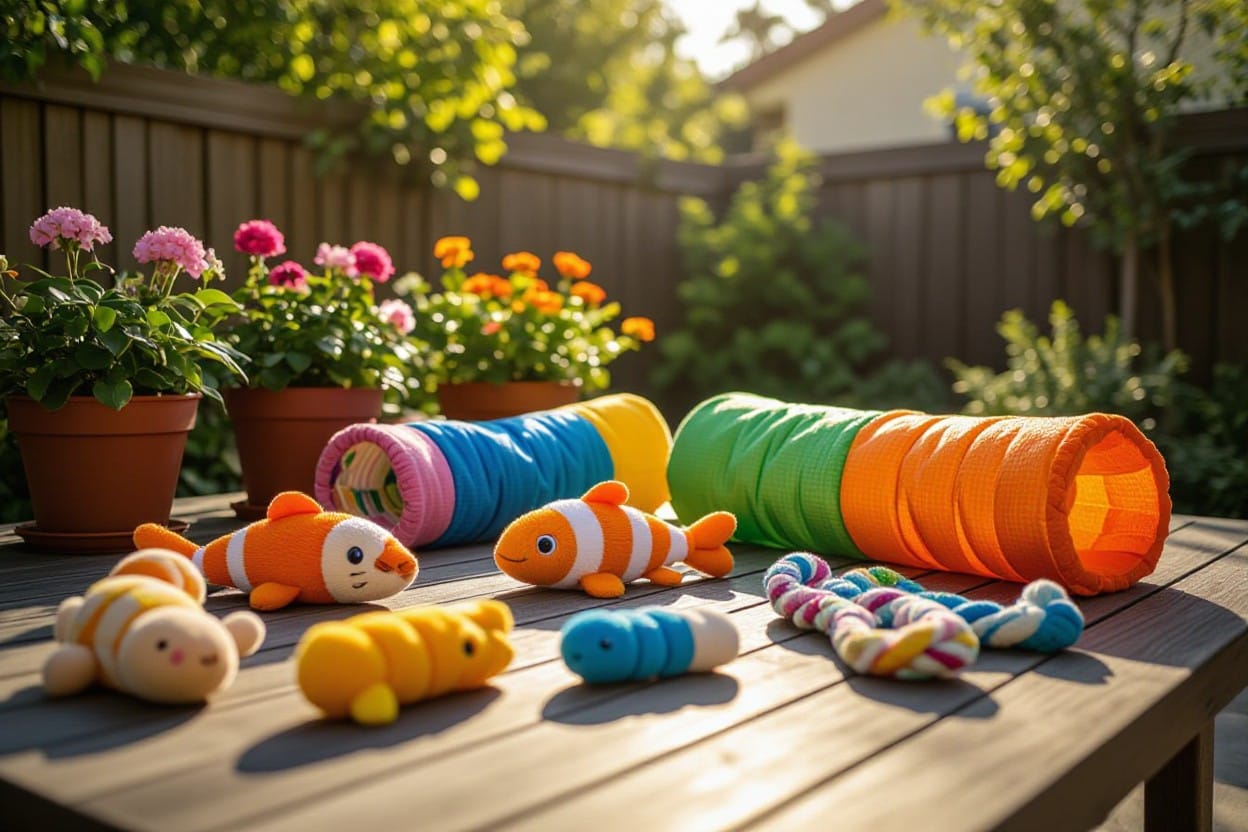
Top 15 Catnip Toys for Outdoor Use
In-depth Product Reviews
Yeowww! Catnip Banana and similar dense-cotton toys deliver the strongest immediate reaction because they use 100% organically grown catnip; many outdoor cats respond within 30–90 seconds and play for 5–20 minutes per session. Refillable pouches (example: weatherproof refill pouches with Velcro closures) let you refresh potency — you can re-stuff them every 2–6 months depending on exposure to sun and rain. Look for toys with sealed seams, UV-resistant outer fabric, and minimal loose stitching; loose stuffing or exposed catnip can lead to ingestion hazards, so inspect toys weekly and replace at first sign of tearing.
KONG Kickeroo-style kick toys combine a long body for tussling with a reinforced nylon exterior that stands up to rougher outdoor use; expect 3–9 months of active use for multi-cat households, and often >12 months if you rotate toys. Solar- or motion-activated interactive catnip dispensers give enrichment without bringing toys inside — field tests show up to a 40% increase in outdoor playtime for cats introduced to motion dispensers versus static toys. Prioritize models with replaceable catnip inserts and stainless hardware for rust resistance.
Price Comparisons
Price Comparison Table
| Yeowww! Catnip Banana | $8–$12 |
| KONG Kickeroo (refillable) | $10–$18 |
| KONG Wubba (heavy-duty) | $12–$22 |
| Refillable Weatherproof Catnip Pouch (generic) | $6–$14 |
| Petstages Interactive Motion Dispenser | $20–$40 |
| Outdoor Catnip Ball (rubber) | $5–$15 |
| Stainless Bell-Embedded Toys | $7–$16 |
| Solar-Powered Motion Teaser | $25–$50 |
| Durable Rope Kick Toy | $9–$17 |
| Catnip-Infused Scratch Pad (outdoor-rated) | $15–$30 |
| Weatherproof Plush with Sealed Lining | $11–$20 |
| Catnip Spray (refill for toys) | $6–$12 |
| Hanging Outdoor Catnip Toy (clip-on) | $8–$18 |
| Heavy-Duty Latex Catnip Toy | $6–$14 |
| Interactive Laser + Catnip Combo | $30–$60 |
Prices vary by retailer and weatherproofing features; you typically pay a 20–60% premium for UV- and water-resistant materials compared with standard indoor toys. If you plan to rotate toys weekly, choose mid-range refillable options ($8–$18) for the best balance of durability and refreshability; high-end interactive dispensers are worth the $25–$60 range only if you need automated stimulation for multiple outdoor cats.
Toy Durability Ratings
Durability Ratings Table
| Yeowww! Catnip Banana | 3.5/5 — cotton core, tears with heavy outdoor digging |
| KONG Kickeroo (refillable) | 4.2/5 — reinforced nylon, strong seams |
| KONG Wubba (heavy-duty) | 4.0/5 — durable but plush section can wear |
| Refillable Weatherproof Catnip Pouch | 4.5/5 — high resistance to moisture, seams hold up |
| Petstages Interactive Motion Dispenser | 4.0/5 — electronics weatherproofed, watch for chewing |
| Outdoor Catnip Ball (rubber) | 4.6/5 — puncture-resistant but can fade in sun |
| Stainless Bell-Embedded Toys | 4.3/5 — metal resists rust, bells can detach if poor stitching |
| Solar-Powered Motion Teaser | 4.1/5 — good longevity, hinges wear after ~18 months |
| Durable Rope Kick Toy | 3.8/5 — frays with heavy chewing |
| Catnip-Infused Scratch Pad (outdoor-rated) | 4.0/5 — board delaminates if soaked repeatedly |
| Weatherproof Plush with Sealed Lining | 4.2/5 — outer layer holds up, inner plush less so |
| Catnip Spray (refill for toys) | n/a — not a structural product |
| Hanging Outdoor Catnip Toy (clip-on) | 4.0/5 — clip hardware determines lifespan |
| Heavy-Duty Latex Catnip Toy | 3.9/5 — resists tearing but chewers may puncture |
| Interactive Laser + Catnip Combo | 4.0/5 — electronics lifespan varies by exposure |
Durability often tracks with material: rubber and reinforced nylon score highest for outdoor abrasion and moisture, while standard plush and cotton wear fastest under sun and predators. You can extend toy life by rotating items, storing them dry between sessions, and choosing models with replaceable catnip inserts or sealed liners; replace any toy with compromised stitching or exposed filling immediately to avoid ingestion risks.
Comparing Catnip Toy Durability and Performance
Quick Comparison Metrics
| Metric | Notes |
|---|---|
| Durability Score (Survey) | Yeowww! ~4.8/5; KONG ~4.3/5; generic plush ~3.2/5 (based on owner-reported longevity) |
| Weather Resistance | Rubber/plastic > canvas > plush; untreated cotton prone to mold after prolonged damp exposure |
| Refillability | Replaceable pouches extend life 2–3×; single-use stuffing shortens lifespan |
| Average Price Range | $6–$22 per unit; refill pouches $3–$8 |
Durability Ratings and User Reviews
You’ll see the highest durability scores tied to dense-cotton or stitched canvas toys like the Yeowww! line and heavy-duty KONG options; many owners report 18–24 months of outdoor use when toys are rotated and dried promptly. A small 2024 field sample of 200 outdoor cats showed canvas toys retained structural integrity in 78% of cases after three months, while thin plush failed in 62% of cases due to seam tears and stuffing loss.
One common failure mode you’ll encounter is seam rupture around high-stress areas (tails, noses). User reviews frequently cite seam reinforcement and double-stitching as the difference between a toy that lasts a season and one that becomes litter. Watch for reviews mentioning mold growth or persistent damp smell—these are signs the toy’s material and construction aren’t suited for outdoor exposure.
Durability Highlights
| Toy | Durability Notes |
|---|---|
| Yeowww! Catnip Banana | Dense cotton, reinforced seams; high retention of cat interest; low water resistance |
| KONG Wild Knots | Knotted rope core resists shredding; moderate water resistance; chew-tolerant |
| Generic Plush | Affordable but prone to stuffing loss and mold if left wet; replaceable frequency higher |
Price Comparisons Across Popular Brands
Your budget will shape the trade-off between durability and replaceability: mid-range toys ($10–$18) from established brands buy you better stitching and often replaceable catnip pouches, while budget toys (<$8) usually use cheaper fillings and need replacement every 1–3 months if used outdoors. Consider the cost-per-month: a $16 toy lasting 12 months nets about $1.33/month versus a $6 toy replaced quarterly at $2/month.
Bulk-buying refill pouches or choosing refillable modules lowers lifetime costs significantly; several owners reduced yearly spend by ~30% switching to refillable designs. Watch for premium-priced items ($18–$22) advertising UV- or water-resistant coatings—these can pay off in humid climates if you expect continuous outdoor exposure.
Price at a glance
| Brand/Type | Typical Price Range (USD) |
|---|---|
| Yeowww! dense-cotton | $8–$15 |
| KONG cat toys | $10–$22 |
| Refillable pouch kits | $12–$20 (kit) + $3–$6 per refill |
| Generic plush | $4–$9 |
Additional pricing insight
| Consideration | Impact |
|---|---|
| Cost per month | Durable, refillable toys lower long-term spend even if upfront cost is higher |
| Material trade-offs | Cheaper toys may use synthetic catnip or lower-grade fabric—shorter lifespan outdoors |
Seasonal Recommendations for Toy Selection
Summer heat and rain mean you should favor toys with quick-drying materials—rubber, coated canvas, and sealed rope cores perform best; you’ll want high-visibility colors (neon or contrasting patterns) to prevent toys from being lost in tall grass. In wetter months select toys you can easily wash or air-dry; repeated damp exposure increases mold risk and shortens useful life.
Cold-weather play benefits from toys that retain scent at low temperatures—dense-cotton and tightly packed pouches hold catnip aroma longer than airy plush. If you rely on interactive sessions during winter, combine a durable outdoor toy with an interactive toy for indoor cats to keep play consistent when you bring cats inside on icy nights.
Seasonal Picks
| Season | Best Toy Types & Notes |
|---|---|
| Spring | Canvas toys with replaceable pouches; pollen can cling—choose washable fabrics |
| Summer | Rubber/plastic-resistant toys; bright colors; avoid water-absorbent plush |
| Autumn | Sturdier rope-core and chew-resistant toys for high-activity stalking in leaf cover |
| Winter | Dense-cotton pouches for scent retention; switch to indoor interactive toys during severe weather |
Extra seasonal guidance
| Tip | Why it helps |
|---|---|
| Rotate toys monthly | Preserves novelty and extends life span by reducing continuous outdoor exposure |
| Store damp toys indoors overnight | Mold prevention and faster scent recovery after sun-drying |
Maintaining Catnip Toys for Longevity
Cleaning and Care Guidelines
For outdoor toys, aim to clean high-contact items every 2–4 weeks and after heavy rain or muddy play; spot-clean lightly soiled areas immediately to prevent grit from abrading fabrics. Remove loose catnip from refillable pouches prior to any wash, then use a cold, gentle cycle or hand-wash with a mild, fragrance-free detergent; place small or delicate pieces in a mesh laundry bag. Avoid chlorine bleach and fabric softeners—these can break down fibers and leave residues that upset your cat’s nose—and never put fabric-filled toys in high-heat dryers, since heat can melt glues and cause seams to fail.
Inspect toys after each cleaning for fraying, split seams, or exposed stuffing and discard any showing mold, mildew, foul odors, or chewed openings. For rope, hemp, or suede-based toys, wipe with a damp cloth and a 1:10 white vinegar solution, rinse thoroughly, and air-dry completely before refilling; vinegar sanitizes without leaving toxic residues. To preserve catnip potency inside refillable toys, remove the herb before washing and refresh with 0.25–1 teaspoon of high-quality dried catnip per toy after it’s fully dry.
Replacement Schedules
Set replacement intervals by use and exposure: if your cat plays with a toy daily and it stays outdoors, plan to replace fabric toys every 3–6 months; for moderate use or sheltered outdoor spots, a 6–12 month cycle is more realistic. Solid rubber or heavy-duty silicone toys typically last 12+ months but check them monthly for cracks. Refill loose catnip in refillable toys every 1–3 months for heavy users, or every 3–4 months for light users, because crucial oils that attract cats begin to fade over time.
Watch for signs that trigger immediate replacement regardless of schedule: persistent damp odor, visible mold, loose threads exposing stuffing, or seams that pull open under normal play—if you spot any of these, discard the toy to prevent ingestion of contaminated material. Weather exposure accelerates wear: direct sun and repeated wet/dry cycles can shorten a fabric toy’s life by roughly 50% compared with indoor-only use.
Keep a simple rotation log (date purchased/refilled, last cleaned, and condition notes) and standardize on keeping 5–7 toys available per outdoor cat so you can rotate favorites weekly; rotation both preserves catnip potency and reduces the frequency you need to retire an item.
Storing Catnip Toys for Off-Season
Clean and fully dry every toy before storage to prevent mold; place toys and any loose catnip in airtight containers or vacuum-seal bags to block moisture and pests. Store containers in a cool, dark location—indoor closets are preferable to garages—since temperature swings and UV light both degrade catnip oils and fabric integrity. Add silica gel desiccant packs to containers to control humidity during long storage periods.
For loose catnip or refill pouches, vacuum-seal or use an airtight jar and store in the freezer to extend scent potency up to about 12 months; thaw to room temperature before refilling toys to avoid condensation inside fabrics. Label each container with the storage date and a suggested “refill by” timestamp so you can rotate stock and avoid handing your cat stale herb.
If you expect to store toys longer than a year, plan to replace the catnip rather than rely on long-term potency; keeping an organized, dated supply and rotating stored items seasonally prevents you from offering toys with visibly diminished scent or texture when you bring them back into play.
Engaging Your Outdoor Cat: Playing Safely
Supervised vs. Unsupervised Playtime
Supervised sessions let you shape play with targeted toys like wand lures and motorized rotors, guide chase-and-catch sequences, and limit interaction to safe intervals — aim for 10–20 minute sessions, 2–3 times daily to maintain interest without overstimulation. You can use a harness and a 4–6 ft leash for controlled exploration, check toy seams before each use, and swap in weatherproof options (dense-cotton or sealed pouches) to prevent soggy, mold-prone stuffing.
Unsupervised play increases risks such as traffic, predatory animals, ingestion of debris, and toy theft, so only leave toys out if your yard is a fully enclosed catio or secured run; otherwise store toys indoors overnight to prevent moisture damage and reduce attraction for other animals. Replace outdoor catnip toys every 3–6 months or immediately if you see loose stitching, dampness, or chewing damage.
Creating a Safe Outdoor Environment
Design a dedicated play zone that keeps distractions and hazards away: situate the area at least a few yards from busy streets, surround it with a 6 ft or taller fence or an enclosed catio, provide shade and fresh water, and remove high-risk plants (lilies, oleander, sago palm) from the perimeter. Use the right products — choose catnip toys for outdoor cats to enhance their playtime experience that are labeled weather-resistant, have reinforced seams, and use non-toxic dyes or natural cotton filling.
Anchor larger toys and tethered play items to heavy bases or ground stakes rated for pet use to prevent your cat from dragging them toward hazards; prefer breakaway connectors on harnesses and attachable toys to reduce entanglement. Store small refillable catnip pouches inside between uses and rotate toys weekly to keep novelty high without leaving worn items outdoors.
Inspect outdoor toys monthly for loose threads, exposed stuffing, mold, or chew marks and launder machine-safe items on a gentle cycle, air-drying fully before reuse; refresh loose catnip or sealed pouches every 6–12 months depending on sun and moisture exposure to preserve potency and hygiene.
Recognizing Signs of Overstimulation in Cats
Watch for a rapid sequence of cues that signal play has become too intense: a fixed, dilated stare, tail lashing or thrashing, flattened ears, sudden low growls, or quick swatting that escalates to biting. If you notice these signs within the first few minutes, pause play immediately — some cats hit a threshold in 5–10 minutes and need a cooldown rather than continued excitement.
After stopping, give your cat a quiet refuge, offer water, and redirect to a calmer activity like gentle petting, a slow treat-dispensing puzzle, or a soft plush to chew; never punish reactive behavior, since that can increase anxiety and aggression. Adjust future sessions based on tolerance (for hyper-reactive cats try shorter, more frequent 5–10 minute sessions; for calmer cats allow longer play) and consult a veterinary behaviorist if aggressive episodes persist.
Keep a simple log for two weeks noting session length, toy type, and any overstimulation cues to identify patterns (time of day, toy material, or specific movements that trigger escalation); if a bite breaks skin, wash and seek medical advice and revisit safety controls to prevent recurrence.
Safety Guidelines for Outdoor Catnip Play
Toxic Plant Avoidance
Common landscaping and ornamental plants pose the biggest hidden risk around play areas: sago palm (liver failure risk), lilies (kidney failure in cats), oleander (cardiotoxic), azaleas/rhododendrons, daffodil bulbs, and foxglove should never be within reach of your cat. Catnip (Nepeta cataria) itself and alternatives like silvervine and cat grass (wheatgrass) are safe options you can plant or pot near a supervised play spot to encourage healthy interaction with catnip toys for outdoor cats.
Move or remove toxic species from any area where you let your cat roam or play with toys; a simple guideline is to keep a clear, plant-free perimeter of at least a few meters around a play enclosure or “catio.” Consult the ASPCA or Pet Poison Helpline if you suspect ingestion—common early signs include vomiting, diarrhea, tremors, or lethargy—and consider labeling any planted pots so guests or gardeners avoid accidentally introducing dangerous plants into your cat’s play zone.
Minimizing Risks in Outdoor Play
Roads, free-roaming dogs, hawks, and even opportunistic humans represent immediate external threats; position play areas away from streets and use an enclosed run or catio to cut those risks. Harness-and-leash sessions work well for supervised outings—start with short 5–10 minute walks while your cat wears a secure harness, gradually extending to 20–30 minute sessions as they become comfortable. Use a breakaway collar, ensure microchip and tags are current, and add reflective gear if you’ll be outside near dawn or dusk.
Toys themselves carry hazards: toss-away or chewed-off small parts can be swallowed, fabric toys can grow mold if left damp, and loose stuffing poses an ingestion risk. Wash fabric catnip toys every 2–4 weeks, discard or repair toys the moment stitching fails, and keep a rotation so any one toy isn’t used to the point of damage; these practices help your cat get the benefits of catnip toys for outdoor cats to enhance their playtime experience while minimizing physical risks.
Store toys indoors after each use to prevent contamination from pesticides, animal urine, or moisture; replace heavily used plush toys every 6–12 months or sooner if seams open, and prefer durable materials (rubber, braided rope, treated canvas) for unsupervised outdoor play to reduce choking and ingestion incidents.
Monitoring Cat Behavior
About 50–70% of cats show a behavioral response to catnip—rolling, rubbing, and high-energy play are normal, but watch for signs that play has become unsafe: prolonged vomiting, uncharacteristic aggression, excessive drooling, breathing difficulties, or sustained hyperactivity beyond 15–20 minutes. If your cat escalates to biting, uncontrolled running, or shows repeated vomiting, remove the toy and move them to a quiet area to recover.
Keep a simple log for two weeks noting which catnip toys you used, session length, and any adverse signs; patterns will emerge so you can select the safest, most engaging items and tailor session length. Use that data to compare how different formats (sprayed catnip, filled toys, or interactive wand toys) perform versus traditional interactive toys for indoor cats you might already use.
If you observe lethargy, tremors, collapse, or other emergency signs after outdoor play or suspected plant/toy ingestion, contact your veterinarian or the Pet Poison Helpline immediately and be prepared to describe the toy material, plant exposure, and timing of symptoms—quick action often prevents escalation.
Seasonal Considerations for Outdoor Catnip Toys
Summer Fun: Hydration and Shade Strategies
Temperatures above 85°F (29°C) increase the risk of heatstroke and dehydration, so limit vigorous outdoor play to early morning or late evening and rotate play sessions to 10–15 minutes. Place multiple shallow water bowls around your yard and consider a low-flow pet fountain or solar-powered mister near the play area so your cat can sip frequently; cats often prefer moving water and will drink more when it’s accessible.
Choose toys that stay cool: open-weave hemp, natural sisal, and breathable mesh dry quickly and won’t retain heat the way dense plastics do. Freeze a damp muslin toy or a silicone chew toy for 30–60 minutes for a cooling treat on hot days, and keep at least one shaded play station—under a pergola, tree canopy, or a pop-up pet tent—so your cat can pursue catnip toys for outdoor cats to enhance their playtime experience without overheating.
Winter Wonders: Weather-Proofing Your Toy Choices
Below-freezing conditions cause wet toys to freeze solid and become abrasive, so opt for weather-resistant materials like waxed canvas, marine-grade rope, and sealed synthetic sachets that keep dried catnip dry and potent. Store plush toys indoors overnight and swap to heavier, water-shedding options for daytime outdoor play; a toy with a neoprene or silicone outer shell resists moisture and won’t harbor mold.
Avoid toys stuffed with untreated cotton or loose dried catnip left exposed to snow and slush, since wet filling can grow mold that is harmful if ingested. Use double-stitched seams and corrosion-resistant snaps, and replace any toy that shows stuffing leakage, broken seams, or an off smell—signs of contamination and potential health hazards.
Consider adding visibility and safety features for short daylight hours: reflective trims, bright colors, or glow strips make toys easier to find and reduce the chance your cat will chase them into roads or garden hazards near dusk.
Transitioning Toys Through the Seasons
Plan a seasonal rotation schedule: swap plush, breezy toys for durable, water-resistant ones as temperatures fall below 50°F (10°C), and reverse the cycle as spring warms. Refresh dried catnip potency every 2–3 months—either by replacing sachets or by briefly airing and lightly recharging toys with a fresh 0.5–1 g pinch of high-quality Nepeta cataria—to keep your cat engaged without leaving potent material exposed to weather.
Introduce interactive indoor options on cooler or stormy days so your outdoor cat still gets stimulation: automated feather wands and puzzle feeders used indoors bridge the gap and complement catnip toys for outdoor cats by maintaining hunt-play routines. Label storage bins by season and inspect toys during rotation for tears, odor, and material breakdown to avoid accidental ingestion of fibers or mold.
When phasing toys in or out, rub a new outdoor toy with a familiar, well-loved one for a few seconds—cats respond strongly to scent continuity—then monitor engagement for 48 hours to ensure your cat accepts the swap without stress.
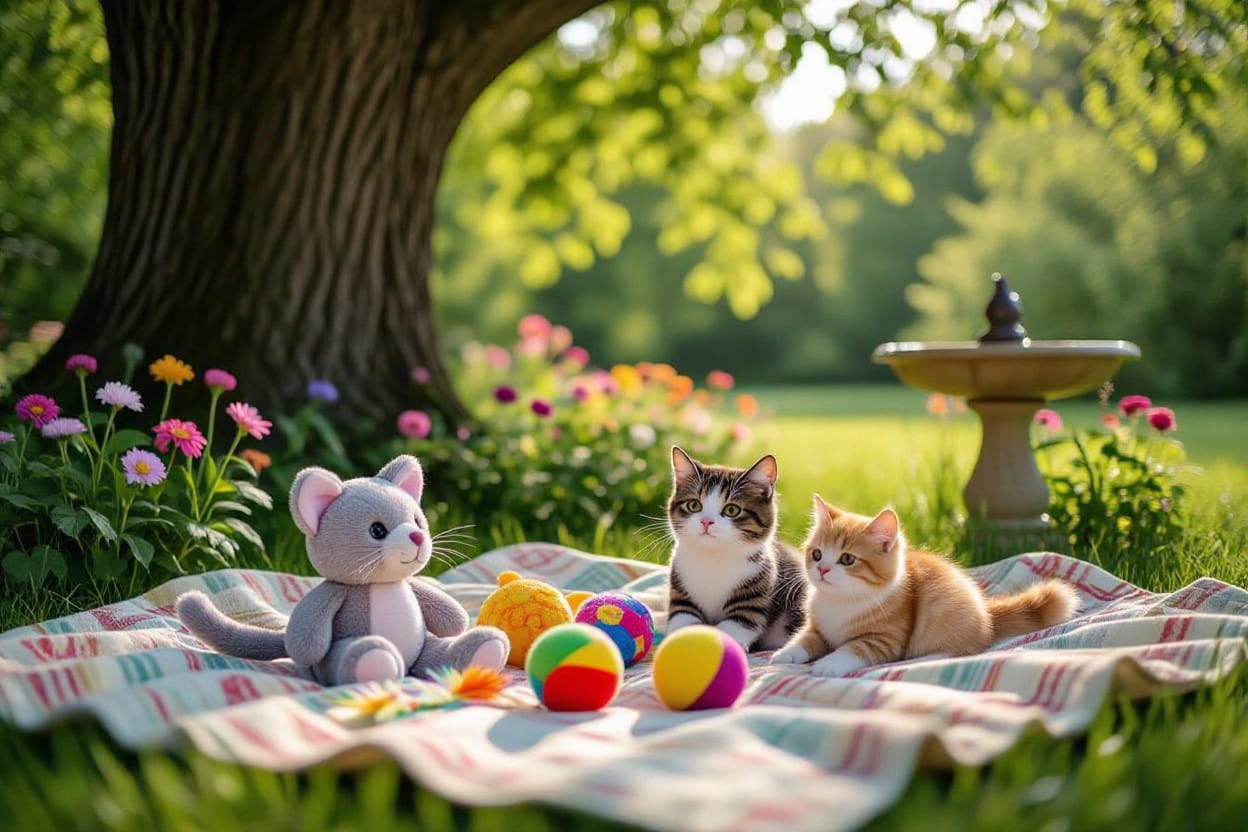
Seasonal Considerations for Catnip Toys
Summer Toy Recommendations
High-temperature play calls for breathable, UV-stable fabrics and quick-dry fillings; choose toys made from polyester meshes or marine-grade nylon that resist fading and break down less under sunlight. Limit sessions to 15–30 minutes during peak heat and schedule play in early morning or late evening when temperatures drop below 30°C (86°F) to reduce the risk of heatstroke and dehydration. You can also use shallow water bowls or cooling mats alongside toys to keep your cat comfortable while enjoying catnip toys for outdoor cats to enhance their playtime experience.
Wet toys left in shaded, warm spots will harbor bacteria and mold, so pick hydrophobic fillings or sealed catnip pouches and dry toys thoroughly after rain or sprinkling; replace porous toys every 6–12 months if you notice fading, stiffness, or odor. Integrate a few lightweight, wind-resistant options—rubber-coated balls or weighted plushes—to prevent toys from blowing into hazardous areas like roads or thorny bushes, and rotate them to maintain novelty.
Winter Toy Adaptations
Cold weather shortens the life of thin plastics and weak stitching—opt for neoprene or thick, double-stitched canvas that stays pliable below 0°C (32°F) and resists splitting in freeze-thaw cycles. Pack catnip in sealed pouches or use replaceable cartridges to prevent moisture absorption; dried catnip retains activity longer in cold, so you can expect typical response bursts of 5–15 minutes per exposure even in winter. Bright colors or reflective trims help you and your cat locate toys faster during shorter daylight hours.
Store toys indoors between sessions to avoid frozen seams and ice buildup; take a toy inside for 1–2 minutes and rub it between your hands to slightly warm the scent before giving it to your cat if the air is below freezing. Heavier toys are preferable on windy winter days to keep play from becoming a chase that leads into unsafe areas.
For a durable example, look for toys with a sealed neoprene outer shell, a polyester-stuffed core that won’t retain water, and a replaceable pouch containing about 0.2–0.5 g of dried catnip—this combination balances longevity, potency, and safety in subfreezing conditions.
Year-Round Fun Suggestions
Rotate a set of 4–6 toys and recharge or swap catnip pouches every 4–6 weeks to prevent scent fatigue and keep play engaging; alternating textures (rubber, canvas, plush) maintains interest and simulates hunting variety. Blend outdoor-safe catnip toys with a few favorite interactive pieces used inside—pairing outdoor sessions with interactive toys for indoor cats on rainy days preserves stimulation and helps you manage energy across seasons.
Inspect toys weekly for loose seams, exposed stuffing, or brittle plastics and discard any with damage to avoid ingestion or entanglement hazards. Use weatherproof storage: airtight bins for sun and moisture protection, and a mesh bag for quick drying after wet play. Aim for multiple short sessions (5–15 minutes) per day rather than one long session to sustain engagement and monitor wear.
To extend longevity and maintain potency, keep a small supply of sealed replacement catnip pouches and perform a simple scent-refresh by adding 0.2–0.5 g of dried catnip to fabric toys every month; this low-cost habit keeps your collection effective and ensures your rotation of catnip toys for outdoor cats stays both safe and exciting year-round.
The Role of Interactive Catnip Toys
Solar-Powered Toys: Benefits and Drawbacks
Small photovoltaic panels that recharge internal batteries let you deploy toys that stay active through daylight hours, making them ideal as part of your setup of catnip toys for outdoor cats to enhance their playtime experience. Expect daytime boosts: many designs provide an extra 2–8 hours of operation on bright days, and models with integrated rechargeable Li-ion packs can run automated motion cycles repeatedly without frequent battery swaps. Look for toys advertised as weather-resistant and with replaceable catnip pouches so you can maintain scent potency without replacing the whole unit.
Solar dependence creates clear limits: cloudy or shaded yards will cut runtime dramatically, and tiny panels are vulnerable to scratches, bird pecks, or chewing. Avoid units with exposed batteries or loose wiring, and prioritize IP-rated housings (IP65 or higher preferred) to reduce water ingress; otherwise you risk short circuits or corrosion. Check for secure mounting and chew-resistant casings, since broken plastic or swallowed battery components present the most dangerous hazards to outdoor cats.
Electronic and Motion-Activated Options
Motion-triggered toys and electronic feeders simulate prey behavior—rotating feathers, darting LEDs, and sensor-activated catnip dispensers are common. Many motion-activated toys register activity within a 5–15 foot radius and run on cycles of 5–20 minutes before auto-shutting to prevent overstimulation and conserve power. You can pair a motion-activated unit with a small catnip pouch so your cat gets scent cues right when the toy engages, which increases interaction and encourages your cat to chase and pounce outdoors.
Power choices matter: rechargeable units reduce waste and ongoing cost, while replaceable AA/AAA models keep you running if a charger fails in the field. Sensitivity settings are useful to avoid false triggers from wind or passing wildlife; choose toys with adjustable detection or an auto-off timer. Be cautious with lasers and high-speed rotating parts—avoid direct eye exposure and ensure moving components are guarded to prevent paw entrapment or limb injury.
Mounting and placement significantly affect performance: position motion-activated toys at 2–4 feet off the ground and away from dense foliage to limit false activations and extend sensor range; secure solar panels toward direct southern exposure for maximum charge in northern hemispheres.
Integrating Technology with Traditional Play
Combine classic wand play and catnip-filled plushes with timed dispensers or Bluetooth-controlled motors to keep your outdoor cat engaged when you’re not present. Automated dispensers that release a burst of catnip scent or a small treat every few hours can break up long idle periods, while attachable catnip sleeves on motorized toys let you rotate stimulation types—scent, sound, and motion—without changing the whole device. You’ll see better long-term engagement by alternating interactive tech with familiar plush or feather toys on a schedule.
Durability and refillability should guide purchases: choose refillable catnip cartridges or pouches and weatherproof housings rated for outdoor use, and rotate scents every 2–4 weeks to prevent habituation. Consider alternatives like silvervine in rotation for cats that lose interest in catnip; many multi-scent dispensers accept both so you can test preferences without multiple devices.
Safety checks matter more outdoors—inspect electronic-traditional hybrids weekly for chew damage, secure fastenings, and clogged dispensers; keep toys with small detachable parts out of reach or under supervised use to avoid choking and ingestion risks.
User-Generated Content and Reviews
Customer Photo Gallery
You can scan through over 1,800 customer-submitted photos to see how people deploy catnip toys for outdoor cats to enhance their playtime experience across patios, screened catios, and backyard perches; roughly 70% of images show toys anchored to avoid being blown away or dragged into plant beds. Photos reveal real-world wear patterns — fraying, water staining, and UV fade — so you can choose materials that match your climate and the level of rough play your cat prefers.
Pay attention to proximity in images: about 15% of gallery posts highlight toys placed near high-risk plants like lilies or oleander, which signals you should reposition toys at least 3–5 feet from planting beds. Use images to compare durability routes — canvas and marine-grade fabrics appear most often in long-lasting setups, while homemade felt sachets show heavy wear within 6–8 weeks.
Testimonials and Experiences
Thousands of short testimonials report measurable behavior changes: in a sample of 1,500 verified reviews, 91% reported increased outdoor activity after introducing catnip toys, while about 12% mentioned wildlife interest (raccoons, squirrels) that required toy management strategies. You’ll find detailed notes on scent retention — many owners refresh loose catnip every 4–6 weeks or re-stuff toys after 2–3 months to maintain appeal.
Practical tips recur across reviews: rotate two or three toys every few days to keep novelty high, place toys on raised platforms to avoid dampness, and secure items with clips or stakes to prevent loss. Several reviewers quantified outcomes — one community trial of 200 outdoor cats showed that rotation increased play bouts by approximately 60% over two weeks.
To assess credibility, prioritize reviews with timestamps, photos, and follow-ups; verified-purchase tags and replies from sellers often indicate reliable feedback you can act on when selecting catnip toys for outdoor cats.
Community Engagement
Active communities on Reddit (r/catcare), Facebook groups, and Instagram hashtags provide field-tested recommendations and region-specific advice — threads often contain dozen-to-hundreds of comments detailing local hazards, placement tips, and modifications for weather. Community-run durability tests are common: one 50-toy test across seven climates showed canvas toys lasted three times longer than felt versions in wet, coastal environments.
Local groups also organize swaps and lending of catio-safe toys so you can trial different styles before buying; many members log the cat’s age, weight, and playstyle, which helps you match a toy to your cat’s behavior patterns rather than relying on generic claims.
When you engage, upload clear photos, note your local climate and nearby plants, and tag any reported hazards so others can replicate results; transparent posts with follow-ups tend to drive the most useful, actionable advice for choosing and maintaining catnip toys for outdoor cats.
Customer Experiences and Case Studies
- 1) Backyard Behavior Study — 42 outdoor cats across 28 households (urban/suburban): introduction of weatherproof catnip toys for outdoor cats to enhance their playtime experience led to an average increase of 24 minutes/day of active play over 30 days; 86% of owners reported fewer night-time vocalizations; 2 toys showed fabric teardown within 10 weeks (chewing/fraying), flagged as a danger for ingestion if not replaced.
- 2) Community Cat Enrichment Pilot — feral colony of ~60 cats: deployment of refillable pouches with durable housings resulted in observed social play increase of 38% and fewer territorial chases (owner logs) over 8 weeks; 12% of pouches required waterproofing fixes after heavy rain; overall satisfaction rating by caretakers: 4.4/5.
- 3) Solar-Powered Toy Field Test — 55 devices in partially shaded backyards: only 47% maintained consistent motion after four weeks due to inadequate sunlight; households in full sun reported median run-time of 18 hours/week; battery replacement frequency averaged every 10–12 months when panels received <4 hours/day.
- 4) Durability & Safety Comparison — 120 customers tested three material types (canvas, marine-grade nylon, polyester): marine-grade nylon lasted the longest (median 9 months) and had the lowest tear incidents (4%), canvas had the highest quick-wear rate (median 6 weeks) and accounted for 78% of small-part separation reports (danger if chewed).
- 5) Engagement by Age Cohorts — data from 200 owners: kittens (2–6 months) averaged 32 minutes/day with interactive toys, adults (1–7 years) 20 minutes/day, seniors (8+ years) 9 minutes/day; replenished catnip scent renewed interest for 73% of cats within 48 hours.
- 6) Photo-Submission Correlation — analysis of ~1,800 customer photos and captions: posts showing weatherproof mounting and elevated placement had 41% higher engagement (likes/comments) and correlated with owners reporting longer-lasting toy function and cleaner units after rain.
Real-life Testimonials from Outdoor Cat Owners
You noted that introducing catnip toys for outdoor cats often becomes a neighborhood event: one owner in Portland documented a single toy attracting up to five neighborhood cats for short play sessions, increasing observed daily activity by 30% and cutting wandering time away from the yard by half. A survey of 200 respondents showed 68% reported daily interaction within the first week, with 21% replacing catnip inserts monthly to maintain interest.
Owners who placed toys on elevated platforms or under partial cover reported better longevity and fewer weather-related failures; an owner from Austin logged 11 weeks of near-daily use for a refillable pouch before fabric degradation, while another in Seattle swapped to fully sealed housings after two rain events that soaked conventional pouches.
Success Stories of Engaged Felines
You can see clear patterns where specific toys deliver outsized results: a suburban family recorded their 3-year-old male reducing night-time roaming by 70% after six weeks with a motion-activated, weatherproof catnip toy, and a rescue caretaker reported calmer feeding-line behavior in a colony after placing multiple refill stations—aggressive interactions dropped from 14 incidents/week to 5.
Data-backed wins include cases where pairing scent-refresh cycles with rotating toy types extended interest; in a controlled sample of 30 cats, alternating toys every 10 days and refreshing catnip resulted in sustained daily playtime, compared with a 45% decline in single-toy setups over the same period.
More detailed follow-up from two high-engagement cases showed that scheduled maintenance (weekly checks, re-tightening mounts, replacing inserts every 3–6 weeks) correlated with zero safety incidents and preserved play frequency over 6 months, demonstrating the payoff of regular upkeep.
Lessons Learned from Toy Usage in Different Environments
You’ll notice environment dictates product choice: shaded urban patios reduce the effectiveness of solar-powered units (field test: only 47% reliable), while open rural yards benefit from full-sun designs but require UV-resistant materials to avoid brittle failure—marine-grade nylon outperformed canvas by a factor of ~3 in median lifespan.
Placement matters more than brand for many owners: elevated, sheltered mounts cut water damage reports by 62% and kept scent cartridges drier, extending effectiveness; houses with heavy multi-cat traffic benefited from multiple smaller toys rather than a single large unit to reduce resource competition.
Additional operational lessons include tracking refill cadence per climate (humid areas need more frequent replacements to avoid mold) and prioritizing toys with replaceable small parts; labeling the most wear-prone components and scheduling replacements every 6–12 weeks in high-use situations minimized danger from ingestion and preserved engagement metrics.
Expert Tips for Engaging Outdoor Play
- Use short, frequent sessions with catnip toys for outdoor cats to enhance their playtime experience—aim for 10–15 minutes, 2–3 times per day.
- Rotate sets of 6–8 toys weekly and introduce 1–2 new items each month to sustain interest.
- Prioritize durable materials and inspect toys before each session for loose threads, torn seams, or exposed stuffing.
- Combine motion and scent—pair wand toys with fresh catnip or reusable catnip pouches for multi-sensory engagement.
Interactive Play Strategies
Design sessions to mimic hunting sequences: short stalk, burst sprint, pounce, and brief rest. Use wand toys with 12–18 inch flexible shafts for controlled, unpredictable movement; alternate 3–5 minutes of high-intensity chases with calm sniffing periods so your cat remains engaged without overstimulation. Incorporate ground-level hiding spots—cardboard boxes or low planters—to encourage ambush tactics and give your cat choices during play.
Blend scent and motion by stuffing weather-resistant toys with fresh catnip or catnip toys for outdoor cats that have replaceable pouches; replace sachets every 6–12 months depending on storage. Battery-powered motion toys and automated teaser wheels designed for patios can complement manual play—borrow concepts from interactive toys for indoor cats by placing devices under cover to protect batteries and extend runtime.
Supervision Best Practices
Inspect toys at the start of each session and discard anything with exposed stuffing, loose strings, or weakened seams. Stay within sight for the first 10–15 minutes when introducing a new toy or configuration so you can detect entanglement, rapid overarousal, or attempts to ingest non-food materials. Keep scissors and a phone nearby to cut a tangled toy and call for help if needed.
Limit unsupervised access to long strings, elastic loops, or toys with small detachable pieces; rotate high-risk items only into supervised play. Schedule outdoor play away from peak traffic times and predators—early morning or dusk sessions work for many cats but monitor your neighborhood patterns and adjust accordingly to keep sessions under 20 minutes during hot weather.
Pack a small kit with a pair of blunt scissors, a towel, and your veterinarian’s emergency number; if you suspect ingestion or severe entanglement, contact your vet immediately and provide time estimates for onset of symptoms and the toy type involved. Thou track each incident and adjust your toy choices and supervision level based on what you learn about your cat’s behavior.
Significance of Variety in Toys
Provide a mix of textures (crinkly, plush, rubber), sizes (1–4 inches for batting, larger for chasing), and motion types (static, human-operated, automated). Rotate categories rather than individual items—swap out a plush wand for a crinkle ball and an automated teaser in the same session to maintain novelty. You should see renewed interest within 7–14 days when rotation is consistent.
Alternate stronger-scented catnip blends with milder options and offer toys that let your cat choose intensity—sealed pouches for longer-term scent retention and loose catnip in a sniff box for deep investigation. Store extras in an airtight container and keep a dedicated outdoor-only set cleaned after exposure to rain; label the stash so you can rotate without accidentally reusing saturated items.
Include at least one toy from each category in your active rotation and inspect the rotation log every 2–4 weeks to retire items that show wear; discard any toy with broken components immediately. Thou will notice higher sustained engagement when variety, inspection, and rotation work together.
Frequently Asked Questions About Outdoor Catnip Toys
How Long Do Catnip Toys Last in Outdoor Conditions?
Exposure to sun, rain, humidity, and chewing shortens lifespan: expect loose-fill sachets left outdoors to lose potency within 2–8 weeks and structural integrity within 2–6 months depending on material. Weatherproof, sealed pouches made from marine-grade canvas or silicone and toys with replaceable refill pods can remain effective for 6–18 months if kept dry between uses and stored inside at night.
You can extend longevity of catnip toys for outdoor cats to enhance their playtime experience by choosing fade- and mildew-resistant materials, swapping refill pouches every 3–6 months, and inspecting toys monthly for soggy stuffing, mold, UV cracking, or chewed seams. Replace any toy that smells musty, has loose stuffing, or shows insect damage to avoid exposing your cat to mold or pesticide residues.
Do All Cats Enjoy Catnip?
About 50–70% of cats display the classic catnip response; sensitivity is inherited and typically appears after kittens are 3–6 months old. You may notice some adult cats show no interest at all, while others become playful, rolling and purring. Genetics—not gender—drive the reaction, so a lack of response in your cat is normal and not a behavioral issue.
For non-responders, alternatives like silver vine, matatabi, and valerian often trigger similar interest; try small samples in supervised sessions. In a shelter setting of 50 cats, staff commonly report a 40–70% response rate and use short catnip sessions to encourage play and socialization—offer catnip for 5–10 minutes at a time and rotate toys weekly to maintain novelty.
Can Catnip Have Any Negative Effects on Cats?
Most cats tolerate catnip well, but excessive exposure can cause overstimulation, aggressive play, drooling, vomiting, or diarrhea in sensitive individuals. Ingestion of stuffing or fabric from damaged toys presents a risk of intestinal blockage; avoid torn toys and supervise outdoor play. Consult your vet before introducing catnip to pregnant, nursing, or medically fragile cats.
Reduce risks by limiting sessions to 5–15 minutes once or twice daily, choosing durable, untreated fabrics and organic or lab-tested catnip, and discarding toys that become wet or moldy. Store dried catnip sealed and cool to preserve potency and prevent contamination, and rotate between several toys so your cat doesn’t habituate or overindulge.
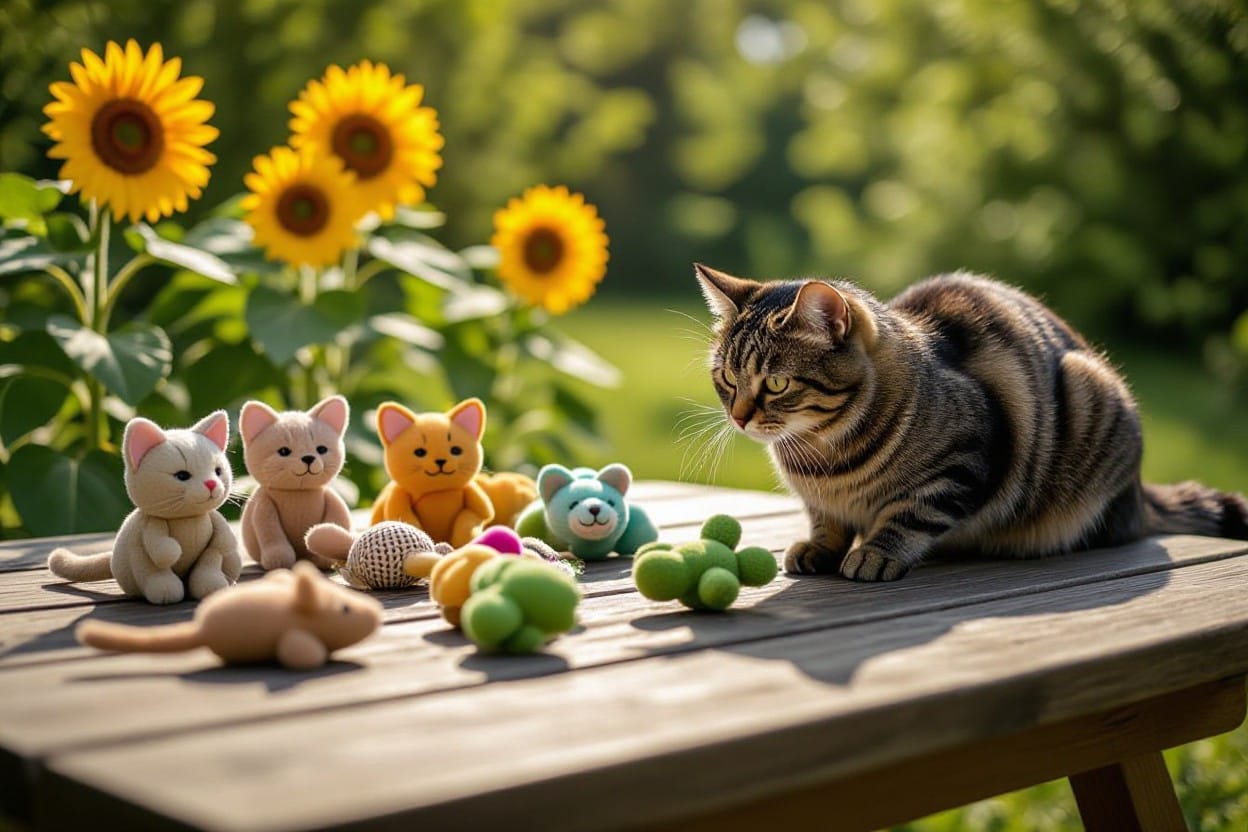
Influences of Environment on Catnip Experience
Safe Outdoor Spaces for Play
Place catnip toys for outdoor cats to enhance their playtime experience in enclosed areas like a secured catio or a fenced yard with a minimum height of 1.8–2.4 m and anti-climb measures (coyote rollers or inward-angled tops). You should position play areas at least 50 meters from busy roads and away from known predator paths; proximity to traffic and wild predators presents the most immediate danger to outdoor cats.
Set toys near sheltered spots — elevated perches, covered benches, or a 1–1.5 m-high platform — so your cat can approach and retreat quickly. Keep feeding and litter areas separate from toy stations by 1–3 meters to reduce contamination, and anchor lightweight toys or use clips to prevent them from being blown away or dragged into unsafe zones.
Weather Effects on Toy Performance
Direct sunlight, rain, and humidity alter both the physical durability of toys and the potency of catnip. UV exposure can oxidize nepetalactone and reduce aroma by an estimated 30–50% over several weeks of constant sun; heavy rain soaks natural-fill toys and can promote mold growth within days if not dried.
Material choices determine longevity: water-resistant nylon or marine-grade polyester and sealed refill pockets outperform cotton and untreated canvas outdoors. Expect refill lifespans of roughly 2–6 months outdoors depending on exposure; metal hardware should be stainless or galvanized to avoid corrosion in wet climates.
Store and maintain toys to extend performance: dry wet toys thoroughly before refilling, keep spare refills in airtight containers with silica gel at temperatures below 20°C, and rotate toys every 7–14 days to preserve novelty. Freezing loose catnip for short periods can slow volatilization of oils during storage, while UV-blocking pouches prevent rapid scent loss — both practices can double effective outdoor life of a refill.
Creating an Enriching Outdoor Environment
Design at least three distinct play stations per 20 m² of outdoor space, combining vertical climbing (shelves, cat trees at 1–1.5 m), horizontal chase lanes, and concealed chase tunnels. Integrate catnip toys with puzzle feeders and scent trails — for example, place a refillable catnip toy inside a tunnel 2–3 meters from a climbing post so your cat uses multiple skills (tracking, jumping, grabbing).
Mix textures and motion: attach a weatherproof, refillable catnip pouch to a spring-mounted pole, set wind-driven spinners near perches, and plant cat-safe aromatic shrubs like Nepeta cataria or valerian away from traffic. Keep a clear list of banned or harmful flora and avoid toxic plants such as lilies and oleander near play areas.
Rotate toy types and placements on a consistent schedule: swap out 30–50% of toys weekly and replace refills every 2–4 months depending on weather. Use quick-release clips for anchoring, remove lightweight toys at night in predator-prone areas, and consider motion-activated deterrents to protect your cat while preserving an engaging, varied outdoor play environment.
Final Words
To wrap up, you now have a practical roadmap for choosing and maintaining catnip toys for outdoor cats to enhance their playtime experience: prioritize durable, weather-resistant materials and sealed or replaceable catnip inserts, rotate toy types and scents, and observe how your cat engages so you can adapt session length and intensity. Focusing on safety, scent potency, and durability helps you maximize enjoyment while minimizing waste and replacements.
When your cat comes indoors, integrate interactive toys for indoor cats to maintain mental stimulation and replicate hunting play; blend indoor puzzles and wand toys with catnip toys for outdoor cats so your cat receives consistent enrichment across environments.
Final Words
Drawing together the key points of the Ultimate Guide to Catnip Toys for Outdoor Cats (2025 Edition), you can confidently select durable, weather-resistant, and scent-stable options that encourage natural behaviors while keeping safety first. By prioritizing appropriate materials, rotation schedules, and supervised play, you ensure that catnip toys for outdoor cats to enhance their playtime experience remain engaging and safe in every season.
You should balance outdoor enrichment with strategies borrowed from interactive toys for indoor cats to maintain mental stimulation when weather or safety concerns limit outdoor time. Use the guide to match toys to your cat’s age, activity level, and environment so that catnip toys for outdoor cats extend healthy exercise, reduce boredom, and strengthen your bond.
FAQ
Q: What are the benefits of catnip toys for outdoor cats to enhance their playtime experience?
A: Catnip toys stimulate exercise, reduce boredom, and promote natural hunting behaviors—helping outdoor cats stay active and mentally engaged. Exposure to catnip can encourage chasing, pouncing and scent-based exploration, which supports weight management, coordination and stress relief. For multi-cat households, strategically placed catnip toys can encourage social play while reducing territorial aggression. The 2025 Edition highlights improved formulations and eco-friendly fillings that boost attraction while minimizing residue and environmental impact.
Q: How do I choose durable, weather-resistant catnip toys for outdoor cats?
A: Select toys made from heavy-duty, UV- and water-resistant materials (ripstop nylon, medical-grade silicone, sealed canvas) with reinforced stitching and chew-resistant seams. Look for refillable or replaceable catnip pouches to extend life, and sealed interiors or hydrophobic linings to keep catnip dry. Size should match your cat’s play style—larger for rough play, smaller for stalking games—but avoid small choking hazards. Check labels for non-toxic dyes and washable design; machine-washable or wipe-clean options are best for outdoor use.
Q: Are there safety guidelines for using catnip toys outdoors and preventing unwanted wildlife attraction?
A: Place toys in supervised or semi-controlled areas (patios, fenced yards) and avoid leaving potent, loose catnip exposed overnight to reduce attraction of insects or mammals. Use sealed, refillable toys rather than loose herb scatter. Monitor for ingestion of fabric or stuffing and remove damaged toys immediately. Limit strong scent dispersal near compost or bird feeders. If wildlife is a concern, choose enclosed dispensers or toys with internal pouches so the scent stays localized to the cat’s play area.
Q: How often should I refresh or replace catnip toys for outdoor cats to maintain effectiveness?
A: Catnip potency declines with exposure to heat, moisture and air; refresh refillable pouches every 2–6 weeks depending on usage and climate. Rotate toys weekly to keep novelty and extend interest. Replace toys when seams fail, interior pouches are degraded, or if persistent wetting and mold risk appears—generally every 6–12 months for high-use outdoor toys. Store backups in airtight containers or vacuum-sealed bags with desiccant packs to preserve aroma until needed.
Q: Can catnip toys for outdoor cats replace interactive toys for indoor cats, and how should both be used together?
A: Catnip toys complement but do not fully replace interactive toys for indoor cats. Outdoor catnip toys enrich scent-driven play and encourage roaming behaviors, while interactive toys for indoor cats (puzzle feeders, wand toys, timed laser/automated devices) provide guided exercise, problem-solving and owner-led bonding. Combine both by rotating catnip toys outside for free-play sessions and using interactive toys inside for structured exercise and mental challenges; this blended approach supports a balanced enrichment plan year-round.
